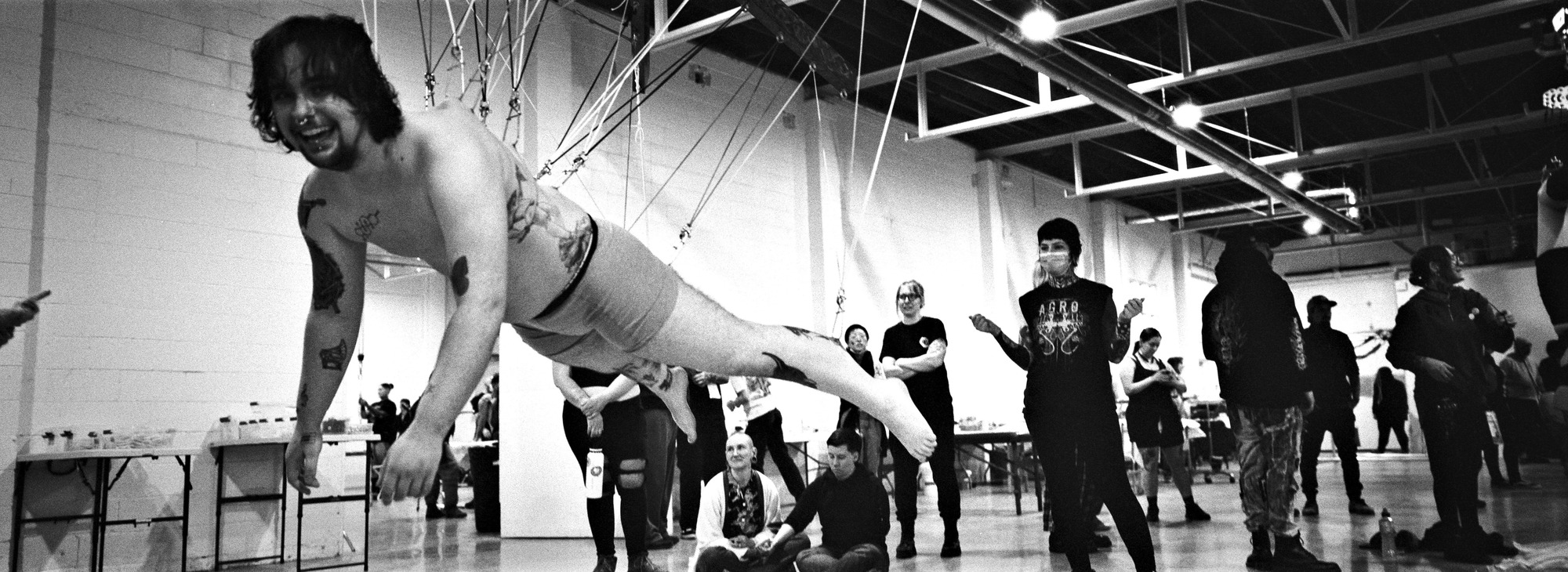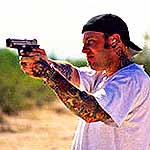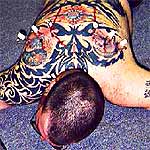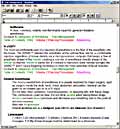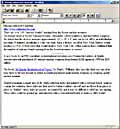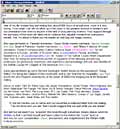
|
-
Lizardman Q & A – Part 5 – Through the Modified Looking Glass
Written by
-
Straightedge and Modified [The Publisher’s Ring]
Written by

Straightedge and Modified “Those drugs are gonna kill you if I don’t get to you first
Make the wrong choice and I’m gonna judge you
I hope that fucked up head can tell you what to do.”- JUDGE, You’ve Lost My RespectStraightedge appears as an interesting connundrum — it advocates a strong sense of community, yet it willfully isolates itself from the mainstream. It advocates clean-living while over-indulging in risky behavior like body modification, glorification of violence, and even body rites. Its adherents aim for serenity while often embracing conflict and choosing fashion statements of guerrilla warfare and gangsterism… Earlier this year BME did a series of interviews on the subject, and, after sitting on my desktop for six months, I’ve finally had a chance to put them together for you here.
 Straightedge (sXe) – Straightedge is a philosophy of “clean living” that espouses a total ban on drugs and alcohol (usually including cigarettes and caffeine), as well as promiscuous (or even pre-marital) sex and other “risky” behavior. The name is based on song lyrics describing the philosophy, and members identify themselves with X’s, often on the back of their hands (mimicking the X’s put on underage attendees at an all-ages show — indicating that they may not be served alcohol).
Straightedge (sXe) – Straightedge is a philosophy of “clean living” that espouses a total ban on drugs and alcohol (usually including cigarettes and caffeine), as well as promiscuous (or even pre-marital) sex and other “risky” behavior. The name is based on song lyrics describing the philosophy, and members identify themselves with X’s, often on the back of their hands (mimicking the X’s put on underage attendees at an all-ages show — indicating that they may not be served alcohol).Militant Straightedge (aka “Hate Edge”) – While most straightedge members chose the lifestyle for personal reasons and are largely concerned with how they lead their own lives, some “militant” members feel that the entire world should agree with them. They adhere to oppressive slogans such as “bring back prohibition” and are known for hateful and anti-social acts such as violently assaulting strangers leaving bars. These groups often choose names including words like “courage”, “honor”, and “discipline”, suffixed with “crew”, giving the public impression that they are a “gang” or militia unit (the literal “Courage Crew”, who the media often pins much of the blame on, encourage their members to be physically imposing and become proficient in “self defence” skills — whether this is an offensive or defensive strategy depends on who you talk to). Instead of focussing on their own problems (and successes, other than edge in and of itself) they focus on the “war” they perceive is going on between those who drink and those who do not.
A number of governments, including the United States, consider forms of militant straightedge a terrorist or cult movement akin to eco-terrorism. Many members glorify the violence by choosing tattoos and icons of brass knuckles, knives, guns, and bats, often festooned with straightedge slogans, while dressing like ‘terrorists’ or ‘guerrillas’ with bandanas hiding their faces and so on. There is a strong neo-nazi element, and their community often suffers from other hate disorders such as homophobia and racism, sometimes echoing oft-co-opted working-class iconography such as the white pride/power movement’s Hammerskins crossed hammers logo.

VIOLENT TATTOO IMAGRY FROM THE
BME ARCHIVES AND OTHER ONLINE POSTINGS.
What’s interesting about hate edge is that it’s almost come full circle from where it all started. Straightedge was “founded” in part to combat the nihilism of early punk, but hate edge embraces this nihilism. It should be noted that sXe founder Ian MacKaye — who has repeatedly said it’s “not about rules” and you can still have an occasional beer (it’s about having a clean life, not blindly following) — doesn’t think much of where sXe has gone.
“I’m a person just like you, but I’ve got better things to do than sit around and smoke dope, ’cause I know that I can cope ... I’ve got the straight-edge.”
- Ian MacKaye (Minor Threat)“Losing/Breaking Edge” – In an almost cult-like fashion, members may be “shunned” if they “break edge” and have a beer or otherwise slip. Often this can result in insults, homophobic accusations (ie. “drinking is gay you fag”), a total removal from the peer group, and even violence.
Straightedge till 21 – Over the past decade, straightedge has increasingly become a youth fashion movement as much as a philosophy of clean living. Because of this, some young people will adhere to straightedge while they’ve got nothing to lose by doing so, and then “lose the edge” when they are old enough to drink legally.
Well over a decade ago I spent a year — as an artist — researching LSD use in combination with bloodletting in the development of both an artistic and a spiritual voice. As a result I was offered and accepted a full fine arts scholarship to York University and there was able to pursue modifications more seriously, and I also met my current business partner as well as a friend who’d later help me create BME (as I didn’t own a computer at the time suitable for publishing). My conclusion from all of my experiences is that — when used responsibly — the role of psychotropic and psychedelic drugs is very similar in destination to body-oriented ritual. I also believe from my personal experiences that the psychiatric effects — the “redefinition of self” — that comes with mind-altering drug use echoes the redefinition that comes with body modification.
In addition, my feeling is that even without these similarities, straightedge was incongruous with body modification since it involved injecting foreign substances into the body and certainly fell into the same “risky behavior” category as sex — and one could argue that there were “addiction” issues as well. Body ritual I figured was a definite no-no on account of willfully inducing altered states!
Because of that, it came as a surprise when one of the most visible and vocal body modification groups that developed as tattoos and piercings popularized was the straightedge movement. At this point “drug free” subcultures represent between 10% and 15% of IAM’s membership. Most of the encounters that I recognized as being with straightedge people were militant — typically after they’d gotten in one dispute or another. To cite a recent example, after being asked why he had posted death threats against members of BME involved with drugs*, and how he would feel if the situation were reversed, Danny “I wear the X as a symbol of war” Trudell (of Seventh Dagger) wrote me,
If you want the right to say “look at me I have cut off my genitals and am an utter freak” then you would have to extend the same privelige [sic] to others and their views and lifestyle choices. Grow up and hey while you are at it get the mother of your deformed child not to drink while she is pregnant next time.
Not that it’s a sin unique to edge, but apparently he didn’t understand that there is a difference between loving yourself, and hating others!
* To avoid accusations that I’m misleading you, the issue began with a graphic shirt he was promoting on IAM saying “KILL YOUR LOCAL DRUG DEALER”. Like it or not, IAM, like all large international communities, has many members who are involved in drug trafficking, sometimes legally, sometimes not, depending on the culture they live in. Whether you agree with the act or not, one of IAM’s core philosophies is that you can’t threaten to murder your fellow members!These sorts of baseless (outside of anything else, my wife doesn’t drink and my daughter is high-functioning and certainly not “deformed”) and bizarre attacks — reflex-like anger responses really — had me believing the stereotype (perhaps falsely) that most people were straightedge because of some sort of internal conflict, self-esteem issues, or childhood trauma that was making them unable to think clearly on the subject. These interactions seemed to typify the relationship that the militants were fostering with mainstream society, needlessly alienating themselves and non-militant straightedge in the process — as they say, the squeaky wheel gets the grease… and a bad apple ruins the lot.
Of course, on the other hand I knew people like Phish of Slave to the Needle in Seattle, or Brian Decker (“xPUREx”) of Sacred Body Arts in Manhattan, both very talented piercers and modification artists — and of course Emrys Yetz, the driving force behind the influential suspension group Rites of Passage, to name just a few of many. All are vehemently straightedge, but sane, lucid, and deeply involved with body modification and mind-altering body ritual. I decided to sit down with them and others to talk about how their straightedge lifestyle fit in with their body modifications. After a little arguing back and forth, we were also joined by Danny Trudell who I quoted earlier.
BME: Tell me a little about what straightedge means to you, and why you chose it for yourself?
PHISH: To me, straightedge is not indulging in mind altering addictive substances that will affect my quality of life — or the lives of those around me. This includes alcohol and all drugs that aren’t prescribed to me for strictly medical use. It also includes tobacco. I saw my own life and the lives of my friends and family being so drastically affected by my early drug use, that I made a pledge to stay away from things that affected me in that way.
EMRYS: Straightedge is a drug free lifestyle. Some say you can’t drink caffeine, some say no sex before marriage, and some people go as far as saying you need to be vegan as well. In my eyes as long as you’re free of drugs and alcohol you can call yourself straightedge. I usually just say I’m “drug free” — not “straightedge” — to avoid the stereotypes.
BRIAN: I also usuaully use “drug free” or “poison free” over straightedge to describe myself nowadays. A stigma has been attached to that term that exudes such a negative characterization. I am not this person — don’t let the militant groups give me a bad name, cuz I’m not a bad guy!
Anyway, it’s a drug-free path which allows me to deal with life — its problems and its fun — with clear judgement 100% of the time. I chose it because if I can’t see something for what it really is, without distortion, I don’t need to see it at all. I know myself to be a fun and outgoing person without ever needing the “help” that some people have told me they need to find this person inside themselves. I like to think I’m a stronger person because of it.
JASON: For me it’s trying your hardest to live a low-risk lifestyle and keep your body clean, natural, and healthy. By low risk I mean sickness and disease — no promiscuous sex! I also feel that veganism is a natural extension of sXe since meat is merely an intermediary between you and chemicals, at least as far as agri-business is concerned.
I decided to stop drinking after a really drunk night in college — when I figured it would be a good idea to attend the riot I heard about on the news. At the end of it I’d been shot by the police and beaten extensively with batons! Alcoholism runs in my family, as does being a violent drunk, so I figured it would be for the best if I stopped drinking then. At about the same time I met other like-minded people at college and discovered the straightedge community. Before long it was just second nature not to drink, and just chill with friends.
Being straightedge has cleared my mind and body and made me a much more conscientious person. I feel more in touch with my environment and my friends. It’s given me hope and strength where religion has failed me, and it’s taught me to believe in myself. I used Catholicism as a crutch in hard times in the past, but this is not the same escapism.
EMRYS: I was at a very low part of my life — I was motherless, fatherless, and left to raise myself. I was in a haze of drugs, trying to run from my problems, and was about to end up dead like my parents, or in jail. I decided that if I was going to prosper in life I’d have to sober up. I didn’t want to work a dead end job just to make enough money for my next fix, even if it was just cigarettes. I lost a lot of friends when I made that choice, but I feel more alive than ever. I have more energy, I’m able to remember things, and I achieve my goals — I think if I hadn’t become straightedge I’d have slipped deeper into drugged states. Being edge gave me something to work towards, something that no one could take from me, that I could be proud of — I overcame my addictions, and I face my problems sober.
JASON: Straighedge has its downsides as well — I grew up in Dayton (home of the “Courage Crew”, an aggressive straightedge gang) and have gotten a lot of negativity from people who found out I was edge. I’ve even been sucker punched for it — “Do you want a beer?” “No thanks, I’m edge” — WHAM! and I’m on the floor. Through IAM I met a lot of really cool edge people that weren’t militant and just wanted to have fun — then I started calling myself edge again. I’m vocal about it now because I want to show people that there are straightedge people out there who aren’t assholes — straightedge should be something good, not something condescending.
BRUCE: I don’t identify as straightedge — I just haven’t done drugs or alcohol for the last six years in order to save my life. I grew up in the DC hardcore scene in the early 1980s where Ian MacKaye of Minor Threat coined the phrase in the first place, so I’ve probably been around straightedge for over twenty years now — back then it was just a way to alienate yourself from the norm. The community was very tight-knit and cliquish, and very anti-woman.
Now there seems to be an underbelly of violence and preachyness — today’s mosh pits with the thrown punches and karate kicks which purposely do harm to others… When it was just dancing and thrashing sometimes people did get hurt but when someone went down others picked them up — the last pit I was at when someone went down they got kicked in the ribs. You see it in the violent symbols they choose — bats, brass knuckles, knives, and so on. Those were not part of the old movement of politically conscious human rights oriented goals!
It doesn't take a big man to knock somebody down
Just a little courage to lift him off the ground- DROPKICK MURPHYS, Fightstarter KaraokeBME: And what drew you to body modification?
PHISH: My first lobe piercing was in 1979 when I was eleven. I watched a lot of pirate movies and always liked them. When I was fourteen or fifteen I was at a party and saw a tattoo that a friend of my older sister’s had — I can remember the design as if it was yesterday — and started becoming really interested in tattoos.
BRIAN: When I was about ten years old I was going to all the kickass 80s metal shows. You know, Motley Crüe, Skid Row, Van Halen, Metallica, and all that. The older (and so much cooler) people at the shows proudly exhibited their piercings and tattoos. I looked up to them a lot. When I got a little older, the metal turned into punk and hardcore. All the piercings and tattoos were still there — even more so. So, I guess the music I listened to and the people I revered in the bands and in the crowds drew me towards modifying myself for status.
Now, I am modified for the sole purpose of showing off who I am to myself, to my friends, to my family, and to strangers. My drug free tattoos are there to tell myself and remind others how strong I am for what I can do, and the things I’ve achieved. I hear far too often, “You do what with hooks where? You know you have to be fucked up for that. What kind of drugs are you on?” My proud response… none. Suspending is another way I prove to myself how much I can accomplish with my mind.
EMRYS: When I was nine years old I carved “EY” into my forearms with my first pocket knife. When it healed I did it again and again until it stayed. It hurt more to cut it deep so it would stay, but the pain of cutting it was made worth it by the pleasure of having the marks. After I did it I felt energized.
Growing up, my mother hung out with a lot of bikers so I was always around pierced and tattooed individuals. The piercings I wanted most were my nipples because I thought guys had no reason for having nipples — if I decorated them with jewelry, they would serve a purpose. So, when I was thirteen years old I got my nipples pierced, and the woman who did them later apprenticed me!
BRUCE: When I took the drugs and alcohol out of my life, there was a huge void. I didn’t know what to do with myself! I became aware of things in the world I hadn’t really thought about. For some reason piercings and tattoos stood out as a way to separate me from the norm… Within six months I had my lobes pierced and three tattoos and started feeling better about myself. My self-esteem started to rise, and the natural endorphin rush of getting tattooed was a thrill I enjoyed when I thought I’d given up all the things that got me off — yes, it got me off.
JASON: My first piercings were done with a gun the day before I left for college — my girlfriend and another close friend all did it to show we’re together, no matter where we were. I met a few kids at college who were more into mods and discovered BME (this was late 1996). I became immediately fascinated. Like a lot of modded people, I’d read National Geographic all my life, but not until BME did I realize how normal this was — I was addicted and spent hours pouring over the texts and pictures. Slowly the “I would never do that” turned into the “I’m not sure I’m ready for that… yet!”
I got my tragus pierced first, and not long after, another cartilage piercing, and after some encouragement from my friend Ian I plunged into genital piercing, getting a few scrotal piercings, a lorum, an a frenum. Then came July 1, 2001 and iWasCured.
I drove six and a half hours after being told I could do a flesh pull — it seemed like the logical extension after being relatively pierced and tattooed. The drive was horrible, and I was manic the entire time — I kept bouncing between thinking about how amazing this was going to be, and flipping out about what the hell was wrong with me for wanting to so something like this.
But it turned out great.
After a few more visits with iWasCured, Phil [Barbosa] asked me why I didn’t start doing suspensions back in Ohio. I told him I wouldn’t know how, and immediately the crash course in suspension started. Not long after, iHung was born.
Suspension has become my obsession in life. Everything that I see that is taller than me, I quickly analyze it to see if I could feasibly hang from it. Suspending puts me into my mind’s space like nothing else has ever done. I have clarity, and it shows me what my life really means — enjoyment, good friends, and family. After my first suspension in your back yard, I was addicted… I knew it… I was able to think about my life and see myself from an outside perspective — I was able to just witness myself being myself and not trying to be anything else.
Suspending and piercing have helped me get through a lot of rough times. In the past I used the pain of getting pierced to remind me that I was in control of my life, and those moments helped me get my life back in order. These days suspending is even more important in my life because I travel and am able to give others the opportunity to suspend — I see people’s eyes as I hold thier hands when their feet leave the ground. That brief shimmer of reality that overwhelms every sitcom that they have ever been brainwashed by. The tears of pain and joy that people shed, I shed as well… When I assist someone with a suspension, a small part of me is hanging with them. I feel it.
Being raised Catholic I was used to ritualism — when I stopped believing in Christ I began to miss the ritualism of Mass. I think suspensions helped fill that gap. On the same thought, drugs have similar rituals with them — packing the pipe, lighting it for someone else, passing it around the circle. I can definitely see the correlations between drugs and rituals of the flesh… They are different doors to the same room.

BME: I guess what I don’t understand is that if promiscuous sex, putting drugs into the body, and so on are “bad”, then why isn’t “damaging the body” and inducing drug-like states from endorphins (ie. body modification) a bad thing as well?BRUCE: Hey, I love promiscuous sex! But I can’t argue this point — I’m fucking high as a kite when I do a hard pull. There’s a great picture of me at LexTalonis’s second social with my cheeks skewered. I look stoned out of my mind and pretty much was.
JASON: My friends who do drugs have the same conversations with me about their experiences with psychedelics as I do with them about suspension. We each found a path that works for us and there are parallels between these paths. The difference is that with drugs there is an outside chemical being introduced into the body to achieve altered states, whereas with ritual like pulling and suspending, these use the body to achieve those states.
As it relates to straightedge, it is possible to get addicted to the adrenaline or endorphin rush — that’s where the old adage “all things in moderation” comes into play… or is that a cop out? Addiction is addiction no matter what the substance is. So maybe it’s “not straightedge”… But I don’t feel that it makes me any less edge since you can achieve similar feelings through hard workouts, skateboarding, or other rigorous exertion.
Suspensions are like exercise to me — I get a nice workout from it and I feel better afterwards.
PHISH: I don’t believe modifications control our lives like drugs and alcohol do — mods affect us in a positive way. They become part of us — I’m not talking about the spiritual sense, I’m talking about the rather obvious physical way. They raise self-esteem and confidence in ways that drugs can only do for short periods (which are just illusions anyway — and often end in the opposite emotion).
EMRYS: Modifying the body isn’t contrary because you’re changing your body in a way that will eventually heal and sometimes better your body and raise your self-esteem. Drug use on the other hand breaks down the body and causes irreversible damage such as destruction of brain cells, liver cells, and so on — modification practiced responsibly won’t cause any problems like this.
As far as body rites giving a drug-like state, that is your body’s natural reaction to what you are putting yourself through — not something you are taking. It’s produced inside the body. That said, if you’re doing the body rite purely “for the high” then that’s probably not very edge.
BME: I see a lot of young straightedge youth getting new mods constantly — is there a worry that maybe one addiction is being traded for another?
PHISH: I’ve never really subscribed to the “mods are addictive” philosophy. Addiction is a compulsive need and is characterized by things like withdrawal pains — and I’ve never seen anyone have even psychological withdrawal from lack of mods! Anyway, lots of groups patronize our business, not just sXe’rs.
EMRYS: …And not everyone who does drugs is addicted to them. If this is an addiction (and I don’t think it is), this is an addiction that betters me, not one that destroys me.
DANNY: Straightedge, simply put, is abstaining from drugs and alcohol. End of story. Getting too many tattoos is not hazardous to my heath, nor do they adversely affect my ability to function.
BME: Well, it does make it hard to integrate into mainstream society…
DANNY: If I wanted to do that I would drink and watch the Cubs game. I am not interested in mixing in with this society — clean living does not mean “fitting in with society”. I am straightedge, not a member of the Boy Scouts or Young Republicans. Straightedge has nothing to do with fitting in or mixing well with society. If anything, it is totally against fitting in becasue the norm is using drugs, drinking, or smoking, and sXe as a philosophy says, “stop and think about what you are doing, and the consequences it may have — don’t mindlessly consume”.
Society teaches from day one that these destructive behaviours are acceptable, just like they teach you to go to church, get married and have two point five children, animals are for food, or any number of other social “norms” beaten into you from birth. Everywhere you turn society is pushing drugs, but despite society’s desire for me to be unhealthy and appathetic I refuse to join in.
But to return to your original question, anything can be addictive. It is not the purpose of this movement to contol all addictive tendencies — though I would say that the discipline I have learned through sXe has tought me to moderate everything in my life.
BRUCE: With my own mods I have really had to contemplate the consequences before I go through with them. There are mods I like a lot that I won’t get because I would be crossing lines into addiction. So I don’t.
JASON: Straightedge isn’t really about “life without addiction”, it’s about being substance-free… Most sXe kids aren’t willing to talk about this — often times, at least in Dayton, kids claim edge because they don’t know anything else. They go to shows and see the tough guys who dominate the dance floor and want to be them. It’s sort of an upper crust that people flock to without giving it much critical thought. This leads to a lot of “sell outs” since they didn’t really know what they were getting into.
People rarely admit that there are flaws in their decisions, and the addiction trade-off is no different. I know several edge people who drink Mountain Dew (heavily caffeinated) like it is their job — to me that’s pretty un-edge. But edge is a personal decision and not some hard-line rules.
BME: Have your modifications played a spiritual role?
PHISH: My spirituality is from my sense of self; I don’t get it from mods or ritual play.
BRUCE: I think I have become more spiritually in-tune with my body. I just know it better.
EMRYS: By concentrating on my body and modifying it the way I have, it keeps my mind and body working together — it reconnects them when they start to fade apart. I feel in control and more aware of my body as I change it to how I want it to be. When my body is in pain when I’m doing a body rite, my mind has to take care of my body, and my body and mind talk to each other to handle what’s going on — I am aware of both of their messages because they’re working together on a level that they normally don’t achieve.
JASON: Spiritually, modification and body play has given me faith in myself again. After I gave up on organized religion I was deeply depressed — probably because I didn’t have anything to believe in and didn’t have faith in myself. Catholicism had let me down when I realized what it had done to other cultures, and straightedge had let me down due to ignorant assholes stigmatizing it. I’d let myself down and was failing school, and I felt like I was letting down my friends and family as well.
Body modification pulled me out of that shell and when I was emotionally level I did my first pulling. That opened my eyes to the natural energies of people — never before had I felt so at peace and completely moved at the same time. At that moment I realized that there is far more to the world than what I had ever been taught or really told about.
BRUCE: Twenty years ago I took a 30-day mountaineering course — complete outback, backpacking, with no contact with the outside in the Cascade mountain range. Two weeks into the course while crossing a boulder field I fell — my sternum hit a boulder and I was driven into the ground with an eighty pound pack on my back. I was hurt (but not as bad as I made it seem) and had to stay out for two days while the course went on — I gave up. I felt weak and like shit. My younger brother was a professional climber in the Himalayas and I had failed a backpacking course because I couldn’t handle the discomfort.
This tormented me for years, knowing I was weak and weak willed, knowing that I failed, and feeling like the only one who had failed. This hurt and I got therapy, but nothing helped. My self-esteem was obliterated.
That moment I said “take me up”, with the hooks in my back and my feet off the ground, and I swung back and forth, all thoughts of personal weakness were gone — my self-esteem has risen ten-fold since then. I feel worthwhile. I’m not a failure. I kicked motherfucking ass! I’m so glad my life doesn’t revolve around mind-altering substances — I’m so fucking happy I can’t stand it! If that’s not spiritual re-birth, I don’t know what is.
BRIAN: When I ready myself for a modification or suspension, I promise myself I will not back down until I get what I want or need from the experience. I get panic attacks pretty regularly and if I can prove to myself that I can overcome the pain, anxiety, and suffocation that comes from hanging from a single hook over my sternum, then I should be able to deal with a racing heartbeat and unexplainable fears that I know will be gone in five minutes so I can make it to work on the subway in the morning.
BME: And how has being straightedge changed the way that you perceive mind altering ritual play?
BRUCE: Without giving up the drugs and alcohol I would never have known or been aware enough to be involved in these things. Giving up the drugs and alcohol actually opened up something in my life that I now know I could not live without. I went from a used up worthless human being to someone who cares, is strong, and open to a daily world filled with life. I can’t even imagine how I lived with the blinders on for so many years.
JASON: It definitely helped me. I can’t imagine suspending while under the influence of any substances. To me it would dilute the effects of the suspensions and make it more difficult to obtain the clarity that I have during rituals. Then again, it could add a whole other level to it!
PHISH: Straightedge does help me because I can experience all of life in a coherent state of mind. I like to remember all of my experiences. If there is going to be a “spiritual” experience, I’d prefer having it from the experience itself, not from chemicals.
EMRYS: Yes — it’s simple — being sXe meant my mind was clear and my body was clear. I was more able to comprehend and understand what was taking place and happening to me.
BME: Given that rituals traditionally used to seek enlightenment involved drug-assisted altered states, or even non-drug altered states, is there a worry that there could be a conflict if you pursued such a path?
DANNY: I don’t have a lot of experience with this so excuse my ignorance. However, I am an avid runner. I run every day so the closest I can come to understanding what you are talking about is what they call “runner’s high”, when your endorphins kick in from the physical stress of running, making your aches and pains less painful, and making you feel like you can run more. I don’t see this as dangerous — that is not ingesting a mind altering substance, and it’s not engaing in an addictive or destructive passtime.
JASON: For me, being straightedge helps keep me on that path, and I know I’m not being influenced by the substances. If I was asked to take part in a ritual that involved taking drugs, I would politely decline but take in as much of it as possible through observation — I’ve done this with friends on hallucinogens. If I was traveling and had the opportunity to take part in an indigenous ritual that involved some drug use, I’m not certain what I’d do — declining such a once in a life time opportunity would be tough.
EMRYS: As someone who is planning his own version of the Sundance, I’ve had to face whether I want to include tobacco and other mind altering substances to follow the tradition of the ritual. After long thought and a lot of discussions I’ve come to the conclusion that technically it is “breaking edge”, but because it’s in a controlled manner where you’re using the substances for their intended purpose, I don’t think it would be a violation of my beliefs. I have chosen that when the time comes I will stay true to the ritual.
BRIAN: I admit, I take a prescription med every morning, to help keep my heart beating at a “normal” rate, and my tension down — I could easily take the easy way out and drink and use heavier drugs to deal with my problems with anxiety. I know a lot of people who do. I definitely think I’m a much stronger person for doing it “on my own”.
BRUCE: My past altered states achieved through LSD, mescaline, scopolamine, and so on were, to me, false altered states — just dreams. Taking those things out of my system has allowed me to go inside, to discover myself, who I am; not a lie. I do achieve some altered perceptions through body rites, but I view them as clean and pure, because they are totally me. I could never achieve them through drugs.
PHISH: Personally, I’ve participated in a lot of mod-related rituals and have yet to have a truly “altered” state of being. I have had an inflated sense of happiness, well being, and accomplishment… but I don’t view those as altered states of being. I’m not saying these rituals hold no spiritual value, but I believe that many people exaggerate these experiences to fit what they’re seeking.
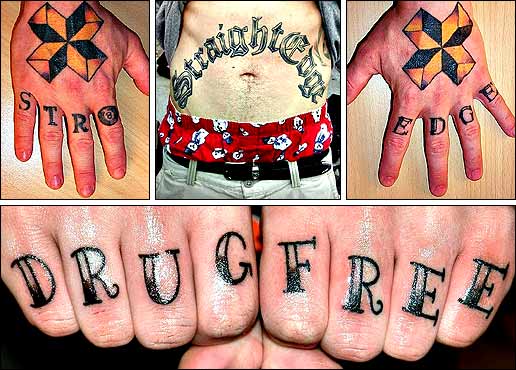
BME: What made you decide to commemorate your straightedge lifestyle with a publicly visible tattoo?EMRYS: For me there were two reasons — like I said, I used to be big into drugs and knew I had to get myself out. But I’m only human and have desires, so I got my “xDRUGxFREEx” tattoo in small sittings even though it could have been done in one. Every time I got the urge to use drugs or drink I would get the tattoo artist to cancel an appointment. Through the pain it would help remind me of my commitment I made to myself, and also remind me of the pain drugs brought me.
Second, whenever people at the shops I worked at asked me for an idea for a tattoo, I told them, “pick something that you are proud of or want someone to know about you just by looking at you” — I’m very proud of overcoming drug and alcohol addiction on my own.
PHISH: I wear my heart on my sleeve not so much for other people but to remind myself of my strength and pride in myself — there is pride in being able to resist the temptation of substances. I’ve never cared if someone else wanted to drink or drug so I don’t really care if someone else notices my tattoos or not. Most of them are hidden — the XXX under my chin, a sober heart on my chest, and sXe bombs on my thumbs. The tattoos are there for me, not for someone else.
DANNY: The tattoos are an extension of who I am and what is a huge part of my life. I’ve poured tons of time and energy into promoting this lifestyle, so naturally I will tattoo my convictions on myself. It’s no different than tattoos involving my decision to live vegan, or my faith in God. Tattoos being a permanent mark on my body blend idealistically with my permanent decision to abstain from what I believe to be a dangerous way of living.
I’ve always loved tattoos, so it’s natural that I blend the things I permanently believe in with that love.
BME: Do you think that’s why most people get the straightedge tattoos?
EMRYS: It comes down to the pride of being straightedge. Most people choose that label for a reason, for themselves, so they want people to know. I think also for a lot of people once you get it tattooed there’s no turning back — it shows another level of dedication that some people aren’t willing to take.
So many people say “I used to be straightedge”, but if you aren’t now you never were, because it’s a lifetime lifestyle and dedication. The people getting tattooed are showing they’re not “true till 21”, they’re “true till death” — and if they’re not, they are left with that tattoo, or the one that covers it, as a constant reminder that they sold out.
PHISH: I think the abundance of tattoos comes more from the scene (EC hardcore) that gave birth to straightedge, rather than the lifestyle itself. But a lot of straightedge kids of very proud of their achievements and it’s logical to fly a flag of pride.
JASON: Many edge people get their tattoos out of competition and peer pressure I think — that’s why they get them in such visible places. It gets them respect in the community, but it also makes them visible targets if they lose edge. I find it sad that so many people who are edge are pushed to get visible work — I know a lot of people that have deep regrets about their knuckles, chests, throats, and hands. It’s also the more militant members that seem to get these, as if to say, “yeah, I’m edge — you got a problem with that?”
If you look at the general trend of edge tattoos, they tend to be aggressive — it’s about creating a “tough” image. I think that some people get edge tattoos to affirm their belief with others, and so they don’t have to be critical of themselves — if they’re not confident of their edge, but have the tattoos to “prove it”, then their peers will keep them in line, if that makes sense… Like the man who gets married to prove that he’s in love instead of getting married because he knows he’s in love.
DANNY: I will say upfront that a lot of kids get crazy straightedge tattoos way too early in an effort to appear cool or tough.
JASON: It’s been my experience that people with the less aggressive straightedge tattoos — simple X’s or “pure” and other variations — are more passionate about their lifestyle and less passionate about “the scene”. They tend to be the clear thinkers, strong in their personal convictions without preaching to others.
BME: Why do you think so many get the tattoos on their throats?
DANNY: How does anyone end up with a throat tattoo? I started with my legs and arms and before you know it, I’ve got tattoos on my hands and throat. I don’t think it’s inherently sXe to get these things. Whether I’d been involved in sXe or not I would have tattoos in these places — I’ve loved tattoos since I was a small child.
BME: Any last words?
JASON: When I am in need of strength I think about all I have done with my body — what I have endured and what I have felt from other people. It makes me realize that whatever is bothering me is probably rather petty in the grand scheme of things. Through body ritual, my eyes, heart, and mind have all been opened up to a greater presence in life and an awareness of those lives. Being edge gave me the clarity to understand what I saw.
EMRYS: Question: “Why do straightedge kids that break edge go emo?”
Answer: “Because it’s easy to cover X’s with stars.”
I’ve avoided turning this into a debate because my goal hasn’t been to suggest that straightedge is for everyone, or that drugs universally enhance ritual. I think though that one overwhelming suggestion comes forward no matter who you talk to: be yourself, tackle life with a clear head, and enjoy and learn from what it gives you.
Straightedge, especially when combined with the tools that modification and body rites have to offer, can be an effective way of helping achieve that — as long as it doesn’t degrade into joyless and narrow-minded oppressive militancy. I think the reason that path so obviously fails is that you can’t define yourself by what you’re not — that is, saying “I don’t do drugs” isn’t who you are. It’s who you are not. The individuals I spoke to above used their straightedge lifestyle to give them clarity which allowed them to find purpose — rather than attempting to have straightedge be their purpose in and of itself.
Body modification fits well with that, because it’s also a tool with a great deal of application in self-discovery and self-improvement. But ultimately, one must always remember that all of these things — even drugs — when used correctly do not add anything. They simply help you to bring out the best in yourself.

Shannon Larratt
BMEzine.comPS. All stories have another side — if you have experiences combining drugs with body rites to achieve spiritual enlightenment, please contact me so I can interview you for that side of things!
While most of the feedback I’ve received on this column has been overwhelmingly positive, it has generated some anger as well, mostly due to the sidebar. The sidebar information is collected from news articles and web sites discussing the subject — people are certainly welcome to dispute them, but please understand that I’m simply repeating what’s already considered fact by the majority of the sources I could find, and not inserting my own opinions or notions. My goal was simply to frame the article with some information that would put it into context for people not experienced with the subject.
Most of this feedback is probably due to the sidebar which speaks negatively of militant straightedge. The sidebar has been edited since this was first published, but since this feedback is from that sidebar I am including the original version here for clarity:While most straightedge members chose the lifestyle for personal reasons and are largely concerned with how they lead their own lives, some “militant” members feel that the entire world should agree with them. They adhere to oppressive slogans such as “bring back prohibition” and are known for hateful and anti-social acts such as violently assaulting strangers leaving bars. These groups tend to choose honor-implying names such as “courage crew” and instead of focussing on their own problems they focus on the “war” they perceive is going on between those who drink and those who do not.
A number of governments, including the United States, consider forms of militant straightedge a terrorist or cult movement akin to eco-terrorism. Many members glorify the violence by choosing tattoos and icons of brass knuckles, knives, guns, and bats, often festooned with straightedge slogans, while dressing like ‘terrorists’ or ‘guerrillas’ with bandanas hiding their faces and so on. There is a strong neo-nazi element, and their community often suffers from other hate disorders such as homophobia and racism, sometimes echoing iconography such as the white pride/power movement’s Hammerskins crossed hammers logo.
Anyway, on with the feedback:
From: Sean Rivers
Subject: response to articleSerisously what in the hell moved you to write that rediculous article. Ive been sxe for almost six years now, and im also courage crew. I can tell that everything you have said in that article is hear say, cause if you honestly new any one in courage crew, you wouldnt have labeled us that way. Like my good friend Kramer said, most of us all have lives and are all grown up. Me myself have a wife and kid and I work my ass off to provide for them. It serisously disturbs me when I see shit like this, how people just out of no where like to bring up lame ass shit like this. You must have no kind of life to actually spend six months to produce that garbage, journalism was obviously not your major. Im a member of the United States Navy, and it really gets me to know that I might have to actually die defending a piece of trash such as yourself. My advice to you would be retract that article, write and apology and get a fucking life. Grow up and stop causing unnecessary shit. But im fine, cause i know just how many people you pissed off, and i have a smile on my face knowing that you'll be looking behind your back for a lonnnnnnnng time. Just remember this, someone knows someone, who just might possibly know you.
ITSN Rivers, United States Navy USS Ford FFG 54
# # #
From: jill encarnado
Subject: you are full of crap!you are full of shit..you and your article. What do you want to prove?..what's with the edge anyway? is it a crime not to intoxicate yourself? or to fuck or to become a vegan? is it affecting your life?! This morons or idiots who claim to be a straight edge is an impostor! i think no real edge would exagerate himself just to get attention..you're doing this for yourself...stop your crap and get on with your life!!!!
# # #
From: "Ozzy Edge"
Subject: your article fabricates the truth a bit too much!!You should be ashamed of yourself for putting such horse shit in you article. I guess it's not your fault because it's evident you're an idiot already, but prejudging, and generalizing sxe as a movement. First off Straight Edge is inside of me, i'm not apart of some sxe movement. There are a lot of sxe kids that I very much dislike. There's no leader, there never was. Again, every arguement made is not legitimate. Anyone can write an article that is truly opinion, and you have down so, with the most ignorant of opinions. I don't know why i'm even bothering with idiots like you because usually I don't care what worthless people would classify me as.
Another fase analysis, the part about why people go straight edge. You're right by accident in one part saying that many fall into because it may seem like a trend to them. However, if we look at that at a national level that's absurd. I was maybe the 2nd person to claim edge in my city, and I know I had to deal with a lot of ignorant people like you saying stuff to me, and maybe that's why now when people are like "ohhhhhh sxe, I heard they're racist, and homophobic""""""""""""';and on 20/20 they said they're idiots" I don't blame them, because idiiots like you mold their perception on straight edge. FUCK YOU. I am not racist, I'm a turkish Canadian and have definetly fought racism with my own hands. I am not Homophobic you asshole, the word fag may slip from my mouth but i have many friends who are gay and i'm all for it..
The whole violence thing: Another false claim. Hate edge. hahah. that's great you almost make people believe that straight edge kids are hateful because of straight edge and not who they were before. You idiot! There are good cops, bad cops. Probobly because maybe 1% is like this, really violent, and aggressive I've never herad of kids waiting after bars to beat up drunk people. That's the biggest fabrication of the truth, ever! Sure some straight edge kids may fight, I will fight to defend my friends, and family. Also, if you ever have been in a part of town that is known for "clubbing" or people getting drunk. You should also take note, you got a pen and pencil chump??? Alright, you should know that drunk people start fights, and maybe sxe kids more often than other kids won't back down. Maybe they're sick of everyone starting fights. Me and my friends never start fights, and half of my friends aren't straight edge. However, people have started with us and we've all fought TOGETHER to ensure the safety of each other. So what if we look out for each other it doesn't mean much... ANd idiot, if you say we're neo-nazia's again, i willl practise this Militant sxe style and say that I spit in your face and punched you because you're not edge. But Reallly it will be the same reason why anyone gets beats up, because they're idiots.
I Hope you make a follow up article, and that's the only way i'll let this shit slide. I can even help you out on that big guy. If not FUCK YOU, you're just as ignorant and as much of an idiot as 70% of the people out there.
love,
XOzzy ErenX The turkish Neo-Nazi ( that makes a lot of sense, just like your article 🙂 ) and don't forget that i was being sarcastic, it seems you wouldn't catch that because of your stupidity.
XXX# # #
From: joshua kramer
Subject: straightedgeI would like to state that your article on straightedge left me deeply offended. I myself am Courage Crew and are in no way militant. I grew up in a household surrounded with smoke and alcohol and decided that i didn't want my life to be like that, for me to be militant i would have to turn my back on my family and some friends. I have been straightedge for 10 years and i couldnt imagine my life any other way.I don't know who you have met that is courage crew or what you have seen but i believe you are deeply mistaken. It seems nowadays when anything involving straightedge and violence it is always blamed on us. Granted there are instances when individuals that belong to this crew have resorted to violence to solve a problem but that is not always the case and has not been for years. For your information we all have similar beliefs and morals in the courage crew. Everyone that is part of this is either in college , over seas fighting, running their own business , or has a trade of some sort, we all follow a lifestyle dedicated to being physically fit, living drug free, training in some sort of self defense and a strong sense of self sufficiency and self worth. Several of the members of of this crew are grown men with families and are in their thirties... an age where violence has a much deeper penalty and could result in the loss of their families and/ or their businesses. I dont understand how any act of violence is concidered militant.If I was in a situation where i was threatened no matter if they are black, white, sober, or drunk i will not hesitate to defend myself as i assume many people straightedge or not would do. The reference to being neo nazis with hammerskin tattoos was absurd, our crew has people of all races and so does straightedge in general, the hammers are from the Judge album and have been adopted to be used as X's since then. I know members of your site that are cxc and are tattoo artists or body piercers that also find this article offending. I don't quite know what your point to writing this was, it seems to me like you wanted to exploit our lifestyle and misrepresent us in a fashion that makes us look like weak barbarians or hypocrites. As far as i can see you know nothing more about straightedge than you did before you wrote your article. This is a belief that thousands hold dear and it should not be made a mockery. "true till twenty one" I have no clue where this "form" of straightedge was concocted but as far as anyone that is straightedge is concerned if you are not now you never were. I have a feeling that you will just take this letter and exploit it on your website somehow and that is fine with me because hopefully the next person who reads this is a bit more opened minded and realizes that there is another way.
sincerely, Josh Kramer
-
The Tattoo Copyright Controversy [Guest Column]
Written by

The Tattoo Copyright Controversy
This article is not intended as legal advice. It is intended for only general information purposes. This article does not create any attorney-client relationship.
When I first came out of the closet as a lawyer to the tattoo community, I was filled with apprehension.Would I be called a poser?
Would I lose my counter-culture cachet?
Would I still be labelled “The Man” despite my extensive knowledge of Ramones lyrics?
About the Author
Marisa Kakoulas is a New York lawyer, writer, and muse of Daniel DiMattia of Calypso Tattoo, living in Liege, Belgium. She works undercover — or just covered up — as a corporate consultant: proof that tattoos and suits are not mutually exclusive. Her book “Tattoo Law”, an overview of US laws affecting the body modification community, is scheduled to hit the shelves in summer of 2004. IAM members can visit Marisa at iam:FREE.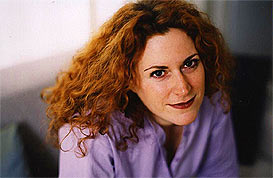
-
William Rafti: Piercing Visionary or Scumbag Con-Artist? [The Publisher’s Ring]
Written by

William Rafti:
Piercing Visionary or Scumbag Con-Artist?
“I’m not afraid of making a fool of myself, I’ve done worse.”
– William RaftiThose of you in the APP know about William Rafti because of his constant baseless attacks on APP members, his cold-calling harassment of those associated with the APP, and his relentless attacks on respected members of the piercing community such as Sky Renfro. Others may have seen his “ebook”, “The Body Piercing Encyclopedia” — which he for a time marketed as the “replacement” for the APP manual — in various online catalogs, through which he portrays himself as one of the leading minds in modern body piercing.
 The photo William Rafti submitted (him in Unimax’s showroom) when he tried to use the BME personals to spam for “trainees” for his non-existent piercing school
The photo William Rafti submitted (him in Unimax’s showroom) when he tried to use the BME personals to spam for “trainees” for his non-existent piercing school
The truth is, William Rafti is at best an unstable asshole with a wavering grip on reality, if you’re to believe the vast majority of the piercing industry. While he’s willing to go on at length about how he’s the most important thing to happen to piercing, even using the references he provided me with, I couldn’t find a single person willing to say nice things about him or even qualify him as an expert. But still, I decided to give him a chance and asked for a copy of his ebook for review — after all, very occasionally an insane asshole does produce something of value.
What I received was emphatically not something of value.
In the mail I received a palm-sized plastic bag with a small unlabelled CD-R, which was wrapped in a low-quality print out informing me that I’d need Microsoft Word to view it. When I inserted the CD there was no installation process or welcome message — upon opening it I discovered that to access the documents, I’d have to copy the contents into “C:\Volume” and load the bits of the book into Word from there.
When I finally got the book loaded, I found a chaotic mess of documents with constantly changing font sizes and colors, strange hyperlinks (sometimes to various Internet sites), and broken layout. It was riddled with spelling errors and grammatical confusion, and there was an abundance of unrelated files — everything from outdated shareware applications to “jokes” to chat logs of Rafti slandering various well known body modification figures. I was rather shocked at the un-professionalism of it, but still, I tried to give it the benefit of the doubt.
The feeling that you get when reading the “book” is that Rafti just downloaded every bit of body piercing related information online, and then tried to patch it together into a single project under his own name. Not only do the fonts change from “pasting to pasting”, but the style of writing changes as well, implying strongly that large portions of this book are plagiarized. In addition, I noticed that in some sections he would flip between referring to tools by their name (ie. 8mm Dermal Punch) and some sort of product code (ie. #DERM-8MM). I can think of no explanation for this other than cutting and pasting from a manufacturer’s catalog and attempting to disguise it as his own work.
And then I read something familiar.
William Rafti was stealing material from the old BME glossary, making minor changes to it, erasing my name, and inserting his own as the author instead!
I don’t generally mind when people use BME as a basis for their own research — that’s what it’s there for. But what I do mind is when people actually claim that they wrote it. If you want to use someone else’s material, cite it properly! It’s one thing when someone plagiarizes on a school project… but for Rafti to steal BME’s material and try and criminally sell it under his own name takes some real gall.
In the tables below, entries from the outdated BME glossary (Rafti did not have access to the new files in the still fledgling BME encyclopedia project at the time) are shown on the left. Entries taken from Rafti’s ebook are shown on the right — please note that in both cases I’ve not always included the entire entry for the purposes of clarity.
I have highlighted direct plagiarism in yellow, and I have highlighted indirect plagiarism (where synonyms and alternate phrases have been inserted) with pink. These are only a small number of the examples that I found — my analysis suggests that the bulk of the ebook is plagiarized from various sources (not just BME). I even found some examples where he copied my typos!
Fistula
A healing tunnel of skin. When a piercing is performed, a crescent hole is carved, leaving a raw length of flesh filled with jewelry. As the piercing heals, new skin is grows. This “tube” is initially fragile and tugging violently on the jewelry will tear it.
Flesh Tube
A healed tunnel of flesh.
When a piercing is performed, a crescent hole is carved, leaving a raw length of flesh filled with jewelry. As the piercing heals, new skin is grown. This ‘tube’ is initially fragile and rotating the jewelry without lubrication can tear it.Changing the title and a couple words doesn’t make a person an author… It makes them a thief (and what’s with substituting “grows” for “grown”?).Blowout
When a piercing is stretched too quickly (a rate which is different for everyone), the skin tunnel can be forced out the back of the piercing by the pressure. The result is an unsightly “lip” around the edge. If stretching continues, this lip can grow dramatically.Downsizing the piercing (ie. putting in smaller jewelry) so that the deformed tissue can reabsorb into the body.
Blowout
When a piercing is stretched too quickly (a rate which is different for everyone), the jewelry tunnel can be forced out the back of the piercing by pressure resulting in an unsightly “lip” around the edge. The best solution is to put smaller jewelry in the piercing so that the deformed tissue can go back into proper position.Again, it’s clearly the same text, with only the most minor of editing to disguise the theft.Flexible Bar Piercing
Another method of doing surface piercings is to use flexible jewelry. The theory is that because the jewelry flexes and moves freely with the body, it will cause minimal irritation. This is true in part, but there will still be more pressure on the exits than with surface bars. Note also that not all flexible jewelry is created equal. The two most common materials are probably nylon (fishing line) and tygon (a kind of plastic tubing). Tygon is drastically more flexible.Flexible Bar
A kind of barbell that has a flexible shaft that is made out of plastic. The two most common materials are nylon (fishing line) and Tygon (a kind of plastic tubing). Tygon is much more flexible than Nylon. The flexibility of the plastic reduces pressure that the skin places on a new piercing, but there is still more pressure on the exits than with a properly fitting surface to surface bar.One of the things that Rafti doesn’t seem to clue in on is that BME “wrote the book” on many of these subjects and still remains the only source for information on them. Because of that, BME often uses unique terminology, and when I see someone else using it, there is really only one possible source! Here he’s “cleverly” changed the focus of the entry from the procedure to the jewelry (and been more sneaky in re-odering the text), but it’s still the same entry, and no one is fooled when they see both I think.Emla Cream
It should be noted that while EMLA cream is over-the-counter in Canada, it is a prescription-only substance in most countries, including the US. In addition, it’s application may be illegal for piercers or tattooists to do.Emla Cream
EMLA cream is over-the-counter in Canada, but it is a prescription-only substance in most other countries, including the US. It’s application may be illegal for piercers or tattooists to do.Come on. It’s not like it’s hard to write entries on these subjects. Why steal?Epinephrine
Epinephrine is commonly combined with injectible anesthetics due to its vascular constrictive properties. That is, it causes blood vessels to shrink closed. This means first that the anesthetic will last longer (since it is not carried away in the blood), and second, the procedure will bleed less.It should be noted that because of its vasoconstrictive properties should be avoided in extremities and digits since the small blood vessels can be permanently collapsed. It should be probably also be avoided by those with heart conditions — injecting 5cc’s of Xylocaine with Epinephrine into your balls will make you feel like you’ve just run around the block.
Epinephrine
Epinephrine is commonly combined with injectable anesthetics due to its vascular constrictive properties. That is, it causes blood vessels to shrink closed. This means first that the anesthetic will last longer (since it is not carried away in the blood), and second, the procedure will bleed less.It should be noted that because of its vasoconstrictive properties should be avoided in extremities and digits since the small blood vessels can be permanently collapsed. It should probably also be avoided by those with heart conditions.
Wow. A whole entry copied word for word… Minus the last sentence, which I guess Rafti thought wouldn’t be right for his readers — although Rafti makes the disturbing and unfounded claim in his ebook that 60% of piercers become piercers due to deviant sexuality including sadism, masochism, and voyeurism.Xylocaine
Xylocaine (lidocaine) is one of the common kinds of anesthetic. In it’s most popular form, it is a liquid injectable anesthetic, usually in a 2% or 1% strength solution. It is often combined with epinephrine.It should be noted that xylocaine is, in most countries, by prescription only and may only be administered legally by doctors. Clients should be wary of any piercing studio that offers it in these countries.
Xylocaine
Xylocaine Also known as Lidocaine; is one of the common kinds of anesthetic. In it’s most popular form, it is a liquid injectable anesthetic, usually in a 2% or 1% strength solution. It is often combined with epinephrine. Lidocaine toxicity can occur when a very large amount of Lidocaine is injected. A common procedure requiring vast amounts of Lidocaine is Super-Wet Technique Liposuction. It should be noted that Xylocaine is, in most countries, by prescription only and may only be administered legally by doctors.What’s funny about this particular entry is what he didn’t steal from me, he stole from rhinoplasty4you.com. Note the two sentences starting Rafti’s second paragrah. Now note this text from the plastic surgery site:“Lidocaine toxicity is something that can occur with way too many injections of Lidocaine. A common procedure requiring vast amounts of Lidocaine is Tumescent and Super-Wet Technique Liposuction.”
Sound familiar? It really gets me wondering whether Rafti wrote any of the text in this ebook.
Marcaine
Marcaine, while usually not as “powerful” as Xylocaine, does last longer. It is often given to patients coming out of surgery to ease recovery.Marcaine has a higher LD50 than Xylocaine, and is not usually appropriate for body modification procedures.
Marcaine
Marcaine also known as Bupivacaine Not as “powerful” as Xylocaine but lasts longer. It is often given to patients coming out of surgery to ease recovery. Marcaine has a higher LD50 than Xylocaine, and is not usually appropriate for body modification procedures.Does this guy really have so little knowledge on anesthetics that he has to rip all this off?Soap
cleansing agent
Many people choose to clean their piercings with an antibacterial soap (such as Dial), but this is widely regarded as unnecessary. Regular soaps work just as well. Saltwater is often preferred, and won’t irritate or dry the piercing as will many soaps.Hand Soap
For cleaning piercings
Many people choose to clean their piercings with an anti bacterial soap (such as Dial), but this is widely regarded as unnecessary. Regular soaps work just as well. Salt Water is often preferred, and won’t irritate or dry the piercing as will many soaps.
Maybe he thinks changing the heading makes him the author of the definition text? Let’s see now, “he” says that salt water is “preferred”… I wonder what he has to say about that subject?Salt Soaks
Soaking an angry or new piercing in warm saltwater is one of the best things you can do for it. Many use saltwater as their only cleanser. Hot, it’s a natural astringent and can be helpful in drawing out infection and pus.Most piercers prefer non-iodized sea salt; although some people have found that normal table salt can be an effective substitute. Conversely, most agree that epsom salts should not be used.
The most common mix is a quarter teaspoon of salt per 8oz of water. The solution should taste as salty as your tears.
Salt Water
Soaking a new piercing in warm salt Water is one of the best things you can do for it. Many use salt water as their only cleanser. Warm Water is a natural antiseptic and astringent helpful in loosening dried lymph, blood etc.Most use non-iodized salt; but normal iodized table salt is also effective.
Epsom salts are not nearly as suitable for soaking new piercings and should not be used.
Saline solution or a salt Water soak can be used; a quarter teaspoon salt to 8 Oz. Water, 8 Oz is equal to one cup, the solution should be no more salty than your tears.
I found this entry copied at least five times in difference places, including his collection of recommended legal forms (ie. aftercare). I have to admit that on top of everything else, I find the bizarre capitalization (Water is a proper noun in Rafti-land I guess) rather amusing and perplexing.Cyanoacrylate
Superglue (cyanoacrylate) is an incredibly powerful and versitile glue capable of acting as a suture replacement, both for play and for medical care. Medically approved superglue is available as Dermabond, but differences between it and over-the-counter superglue are relatively minor.Using glue as a suture alternative, when properly applied, results in dramatically less scarring than sutures (stitches). Superglue was used by soldiers in Vietnam to treat small wounds, and is currently used by many medical and pseudomedical practioners such as midwives who use it as an alternative treatment for vaginal tears.
In addition, some men enjoy using glues for infibulation bypushing the genitals up and wrapping them in pubic and scrotal skin, and then gluing the whole thing together. This generally lasts a few days at most, and relatively painless separation is possible before that with care… assuming the person shaved fully!
Cyanoacrylate
Cyanoacrylate (Superglue) is a powerful glue that usually holds skin together for less than a day. Medically approved superglue is available as Dermabond, but the differences between it and superglue are relatively minor. Cyanoacrylate is used by many personal care givers to treat small wounds and tears of the skin surface such as vaginal rips caused from child birth.Using glue as a suture alternative; when properly applied Cyanoacrylate results in less scarring than suturing a wound closed. Some men use glue to glue their scrotal sack over the penis making it impossible to get an erection until the glue releases. Relatively painless separation is possible before the glue naturally gives way, if the person was fully shaved before the gluing slowly pulling the skin apart may be possible.
At least in the epinephrine entry he took out the part about ball torture… Here for some reason he left in my commentary on that subject, which has nothing to do with piercing.Gauge
The Browne&Sharpe gauge system is used in North America to denote the diameter of the wire used to make a specific piece of body jewelry. The larger the gauge, the smaller the diameter.Gauge
American gauge (also known as Browne&Sharpe gauge) system is used in North America to denote the diameter of the wire used to make a specific piece of body jewelry. The larger the gauge, the thinner the wire.Ooh, what a change. This is such a simple entry, that you’d think he could at least come up with his own text for this one! I’d expect them to be similar, but the same sentences? Unlikely.Skin
An interesting side note here is that if you wash your hands, you actually end up with more bacteria on the surface of your hands than before you washed. This is because by sluffing off the dead cells, you expose the critters growing inside you — however, these bacteria are largely harmless to you (but not neccessarily to others).Washing Hands
If you wash your hands, you actually end up with more bacteria on the surface of your hands than before you washed. This is because by removing some of the dead cells you expose more of the bacteria that is growing inside the surface of your skin, luckily these bacteria are largely harmless to you, but are much more likely to be harmful to others, so wearing gloves is vital no matter how clean you think your hands are.See, now this is worrying. These are really basic subjects. Why is someone who claims endlessly to be an “expert” unable to write their own entries on these simple issues? Just think — this guy is trying to con people into letting him train them.Nitrile
latex-free material often used in gloves
Many piercers are switching over to nitril gloves. Due to their latex-free nature, they are less problematic for people with (the relatively common) latex allergies. In addition, tears and other defects are easier to notice in nitrile gloves.Nitrile, and
Glove, Acceptable Quality Level
Also known as “Nitril”. An alternative synthetic rubber like material that is latex-free and does not cause contact sensitivity as latex can. In addition, tears and other defects are easier to notice in Nitrile gloves. This is currently the preferred choice for most piercers.Due to their latex-free nature, they are less problematic for people with (the relatively common) latex allergies. In addition, tears and other defects are easier to notice in Nitrile gloves.
This is actually one BME entry converted into two Rafti entries — getting his money’s worth I guess (oh wait, the BME glossary is free). In the first one, he’s done some rewriting, but I guess he forgot about the second one and just left it as a pure word for word copy.
Again, this is only a fraction of the plagiarism I discovered from BME and other sources in Rafti’s ebook. The rest are reserved for the lawyers should it come to that.
OK… So do I sue this thief into the stone age? I’m a pretty laid back guy, so I decided to do an interview with him about his book and see what he had to say — I was placing bets with myself on whether Rafti would come clean, “be a man”, and apologize, or whether he’d try and keep the lie going as long as possible.
BME: Large parts of the document are directly based on and plagiarized from my own site and from other sites. Why have you stolen other people’s work and presented it uncited and as your own? Did you really believe no one would notice?
RAFTI: “All mankind is of one author, and is one volume” – John Donne
BME: No, I’m serious. Why did you steal my articles and say you wrote them?
RAFTI: As far as anything that I am aware of that I used from others I had permission.
BME: No, you did not have permission. Why did you steal my articles?
RAFTI: With over six billion people in the world thinking millions of thoughts each there is probably no thought that you can think that hasn’t been thought before by someone else. If you mean to imply my thoughts and words are not my own then we are all guilty by circumstance of the same thing.
BME: Look, you copied word for word. Don’t try and pretend it was just a coincidence. Did you really think I wouldn’t notice?
RAFTI: No one else had a problem like this.
BME: They probably don’t know you stole their material. Maybe I should let them know? Again — why did you think you could steal my material and get away with it?
RAFTI: Nothing in my book was taken from you. Everything I know to be true tells me the opposite of what you presume.
BME: You stole entries from the glossary for example.
RAFTI: I went through every entry in your glossary with the intent of purging anything that I thought might be considered “stolen” from you. My entries were very different than what you had.
BME: Let me be clear here — I am going to publish information on your theft and it’s very clear and obvious. I’m trying to give you a chance here to come clean.
RAFTI: Stop lying. I can find no grounds for these accusations. This is war, [and] I’m making a list of names. The people caught on the losing side will face the obligatory mob reaction, same old story.
So it’s clear that Rafti is either too much of a scumbag to admit his theft, or so insane and unprofessional that he’s totally unaware of it. Either way, it was clear that this line of questions wasn’t going to get anywhere. On his website and in his book, Rafti claims to be the world’s leading expert on body piercing and states that he’s endorsed by many respected industry figures — so let’s ask him about some of those people.
BME: You’ve said on numerous occasions that industry respected individuals are endorsing your book, yet your book appears to be somewhat misleading as to who is actually supporting you — you’ve even implied that I supported it, before I’d even seen a copy! Who are your allies on this project, and who is endorsing it?
RAFTI: I have a list of people who said positive things about my book on my web site.
BME: Those are anonymous names — it’s not as if “branded bitch”, “Brandy H. (IL)”, or “name withheld at request” are people who are recognized, let alone confirmable. Seriously, tell me some people I call and check with.
RAFTI: The people who I have the most respect for in the industry support what I’m doing, including Kim Morin of Prick Magazine (I told her a thing or two she said was worth exploring), and Creeper of Starborn Tattoo in Las Vegas (I went from studio to studio in Las Vegas and could not find anyone who had his experience and knowledge).
There is also Wes of Unimax who is my biggest supporter. John Seaton of the Suffolk Country Department of Health personally told me he’d gladly endorse me. He told me that he had been waiting twenty years for something like this to happen.
David Klaus Pavin Jr (aka Kivaka) — 13 years experience — will bring much useful information to the Rafti Institute school. [And] Jim Ward is a dear friend of mine.
BME: So Jim got you into piercing?
RAFTI: He was my first contact in the world of piercing. I met him in David M.’s studio after Jim invited me to attend a piercing clinic he was offering, where they were using Betadine to sterilize and used no gloves. It turned out to be a frightening experience — I was the only heterosexual there and felt obliged to tell them so. Lots of leathermen went “oooooooh” in unison when they saw me lie down.
Jim invited me to the opening party of Gauntlet, where I also met Elayne [Angel] who personally told me and the whole room that I was “Gauntlet’s second customer, yay!”
OK, time to make some phone calls and emails and see if these stories check out. “Dear friend” of Jim Ward is a pretty big claim, so let’s talk to Jim and Elayne first.
BME: I’m doing an interview with William Rafti, and he’s using you as a reference. Would you say it’s accurate for him to describe you as a “dear friend”?
WARD: If he were a “dear friend” I’d think I’d remember him. The only thing I remember about this guy is that he [recently] sent me a couple of emails asking questions about Doug [Malloy].
BME: He says you guys met at David Menkes and that you’d invited him to the Gauntlet opening and early piercing seminars — and that you all made a big fuss out of him being straight.
ANGEL: He may have been at the NY opening. Probably close to hundreds of people were there…
WARD: I don’t recall inviting him to Gauntlet’s seminars, and, frankly I can’t imagine anyone caring whether he was gay or not.
BME: He also said that you weren’t using gloves or properly sterilizing things.
WARD: There was a period in Gauntlet’s early years when we didn’t use gloves, but I always took care to make sure the implements were sterilized.
ANGEL: While things have dramatically improved since those days (1991 or so), we were pretty state-of-the-art at that time. Gauntlet has definitely used gloves since before my time there (in the 80s).
BME: I assume you know that he also personally thanks Richard Simonton (although he misspells it) in his book…
WARD: I kind of figured this guy for a phony, and not all that in tune with what’s going on. If memory serves me correctly, he initially contacted me saying he wanted to know more about Doug and his connection to the organ world.
As you probably already know Doug Malloy was not his real name. It was the name Richard Simonton used for his piercing exploits. Rafti couldn’t understand why I persist in calling him Doug Malloy when that wasn’t his real name. I thought that was pretty clueless and wrote back that I didn’t think he’d call Mark Twain “Samuel Clemens” in the context of his writing, so why would I call Doug “Richard” in the context of piercing? Don’t know if he got it, but I haven’t heard from him since.
No surprises there. Let’s check with Wes at Unimax.
BME: Were you aware that Rafti stole large parts of his book?
UNIMAX: I’m not even sure that he’s aware of that.
BME: Rafti lists you as his primary reference and biggest supporter, and he quotes you as saying that anyone who doesn’t buy his book has no interest in piercing.
UNIMAX: Well, I changed that. I took that off of my site when I saw that it was a little overbearing. That was just advertising.
BME: Am I correct in assuming your relationship with him is basically the same as you’d have with any of the authors who’s books you sell?
UNIMAX: Yes, but when he showed me the book I was very impressed with the amount of material he compiled.
BME: Well, I think it’s important to note that he didn’t actually write it. I mean, I can’t just go buy a tattoo magazine, scan the photos, and make my own magazine.
UNIMAX: No, definitely not!
BME: Anyway, Rafti says you’re his biggest supporter. Is that accurate?
UNIMAX: I’ve been a supporter of his efforts. I support anybody’s efforts! But I don’t stand behind his work. I’m not saying that. I can’t vouch for his work. I didn’t even read his whole book, it’s impossible to read.
BME: What do you think of Rafti? I can’t tell if he’s crazy or lying.
UNIMAX: He’s a little strange… you know… he’s a strange kind of person. [laughs] Just to refresh. I support anybody’s efforts if they’re doing it legitimately. That was my support of him and it’s as far as it goes. I don’t support anybody who’s doing anything illegal. I never have.
True to his word, as soon as Unimax found out about Rafti’s fraud, they removed his book from their catalogs (Mario from WoodBodyJewelry did the same after finding out about Rafti’s scam). Maybe we’ll have more luck checking with Prick Magazine. Or is that wishful thinking?
BME: I’m trying to get in touch with Kim Morin of Prick Magazine.
PRICK: She hasn’t worked for me for quite a while now.
BME: William Rafti is using her as a reference. Do you know him?
PRICK: William Rafti? Naw, I can’t say that I do, unless he goes by “Billy” and he’s a fat bald guy.
BME: Well, he is kind of fat, but he has hair. How do I get in touch with Kim?
PRICK: Kim didn’t exactly leave on the best of terms… I can’t speak for either one of them. If you could pass it along that they should stop using [Prick] as a reference, I would really appreciate it. But Kim is a good piercer, and if he worked for her…
BME: Oh, he’s never been a piercer.
PRICK: [laughs] Well, what’s he trying to pitch then?
BME: He’s got this thing called the Rafti Institute which wants to offer piercing training courses, and he’s got a plagiarized book about piercing that he tells people he wrote.
PRICK: Weird… I think I remember a guy wanting to get involved with us, starting to talk about publishing a book. But he was a little too far out there for me to deal with.
BME: Yeah, that would be Rafti.
PRICK: Just tell him to cease-and-desist mentioning Prick Magazine next time you talk to him.
No surprises there — although I have to admit that I find it surprising that someone would give out references that aren’t going to say nice things! I tried to track down Kim Morin to hear if she had anything to add, but unfortunately had no luck in doing so.
Next I decided to see if I could find “Kivaka”, who Rafti had said was going to be one of his instructors at the school — touting his 13 years of experience (which I would later find out from Kivaka’s website was an inflated claim). Kivaka works at Tattoo City in Lockport, IL and we had a brief chat about Rafti’s statements — Kivaka had just woken up and seemed a little dazed, but I got the impression he was a nice soft-spoke guy who’d simply been tricked by Rafti’s emails.
BME: William Rafti is listing you as one of his primary references, so I wanted to ask you a little more about that.
KIVAKA: Oh, right on.
BME: How would you characterize his skills as a piercer, and as someone qualified to lead the piercing world forward?
KIVAKA: Well, I’m pretty sure he’s not a piercer…
BME: Have you ever even met Rafti?
KIVAKA: No, I’ve never met him… No… We just corresponded a little across the Internet.
Big surprise… ha.
Next I called Starborn Tattoos in Las Vegas, a shop that Rafti said was the only studio in Las Vegas that was good enough to get an inspection certificate from him. After a bit of phone tag I managed to get in touch with Creeper, an experienced — albeit retired — piercing artist from “the old days”.
BME: William Rafti said you’d act as a reference for him.
CREEPER: Yeah, I know him…
BME: Would you say he’s qualified as one of the best piercing instructors?
CREEPER: Well, no… I was taught by the best years ago. The way all these piercers are nowadays is why I’m not in the business any more.
BME: You don’t pierce any more?
CREEPER: No. The way piercers are taught nowadays I just don’t agree with it. My piercers have to apprentice for a year before I even let them pierce.
BME: You know that Rafti’s school is just a $15 certificate, right?
CREEPER: I didn’t know that… So he’s a scam…
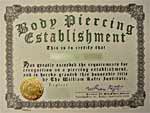
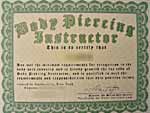
Sample “scam” certificates avaiable from Rafti, available without inspection. BME: You’ve met Rafti in person?CREEPER: Yeah, he came in here and looked around. But there wasn’t a piercer here at the time when he came in.
BME: There was no piercer working?
CREEPER: Nope.
BME: And I guess you can’t really vouch for Rafti’s skills or knowledge?
CREEPER: No.
BME: Has he asked you to instruct at his school?
CREEPER: He asked me something about it, but I said “no way”. I’m just not interested in the piercing thing any more. It’s gone way too wild for me! I pierced for ten years and apprenticed a lot of piercers. I don’t even do it any more. I just tattoo now.
Well, that’s the end of Rafti’s industry references.
Getting in touch with John Seaton of the Suffolk County Health Department was extremely difficult — I called for days, every few hours, and no one was able to ever find him (even Rafti had warned me that he was extremely busy). On my last day of research, when I was ready to write off Seaton as unreachable, he answered and I was able to ask him about Rafti’s credentials.
BME: Do you know William Rafti?
SEATON: I have a disc [from him]; he gave me a disc but I haven’t looked at it yet.
BME: He told me you would vouch for him as a piercing instructor…
SEATON: [laughing]
BME: …and that you’d been waiting 20 years for something like this to happen?
SEATON: [laughing hysterically] …You know, I hate to tell you: the guy came in, he showed a bill of goods, and I looked at him and it just sounded too fishy. You know when something appears to be too good to be true?
BME: He says you trained him and endorse him as qualified?
SEATON: [laughs] He may have been through my certification course and earned a certificate.
BME: What does that course involve?
SEATON: Knowledge of bloodborne pathogens. I teach a little course — a couple hours.
BME: So it’s not something that qualifies someone as a piercer; it just covers the basics of contamination control and so on?
SEATON: Yes — that’s all we can certify. As to skill as a piercer, the law doesn’t address that.
I’m sure no one is shocked at this point, but Rafti’s claims to be endorsed by the Suffolk County Board of Health as a piercer let alone an instructor are stretching the truth pretty thin. He simply took the afternoon bloodborne pathogens course offered by the county to anyone who wants to take it.
So what of Rafti’s lofty credentials? Perhaps he’d at least tell me where his degree was issued — after all, he was claiming not only to be a dude writing a book, but also a scientific researcher (he made the preposterous claim that soaking a piece of body jewelry in brine solution could detect how well it would fare in the body — anyone with even basic knowledge of implant standards as they apply to metallurgy and biology knows the notion is foolish).
BME: You claim to be an expert in this field — what is your actual experience that backs that up?
RAFTI: Thanks for implying that I’m an expert, you can also call me handsome if you want. I claim to be what I already said.
BME: I didn’t imply that you’re an expert, and you didn’t answer my question. Anyway, have you done other research-oriented writing that prepared you for this book?
RAFTI: I’ve written for other publications that would not like being associated with piercing or tattooing in any way, shape, or form so I will not mention them. I have a wall full of credentials — I have credentials for all kinds of things. My mentor, who’s name I am not going to mention, was an international attorney.
I studied anatomy — but don’t quiz me on it. I took a first aid course but my certification expired, and I was certified to run an air compressor.
BME: Ah, so you’re “qualified”, but it’s a secret. I see. In your book you say that you are a piercer and a tattoo artist. Who trained you and where have you worked?
RAFTI: I worked “underground”. The people who I’ve pierced came to me because they thought I would do a good job, distrusted the local studio, and gave me lots of understanding when things occasionally didn’t go as hoped.
I was strongly encouraged to go into piercing professionally — one of the studios that was going to hire me (no apprenticeship) instructed me to answer the phone by saying “Hello asshole, this is asshole speaking, what do you want?”
I will be doing a few tattoos within the next year on people who don’t care if it comes out right. [Editor’s note: That is not a typo — he actually said this!]
BME: Um… Ok. Sounds like you have high standards. So how many piercings have you actually done?
RAFTI: I’ve done about seventy to seventy-five actual piercings on living people and currently have no plans to do any more.
BME: So what makes you qualified to design and run a piercing school, let alone have the egomania to call it “the most advanced piercing course” available?
RAFTI: I’ve done at least seventy piercings, and I wrote my ebook.
BME: Whether you wrote that ebook or not is for the courts to decide. Anyway, have you ever even seen or attended any of the other courses available?
RAFTI: I have not received piercing certificates from any place other than myself, and that was a conscious decision based on my personal beliefs. I do have a proficiency test of my own creation but it is proprietary.
BME: How many students have taken your course?
RAFTI: None.
BME: Sounds successful… so basically, you can’t tell me anything about your imaginary school (or your credentials to run it), other than it’s the best, but the proof is top secret?
RAFTI: I will divulge the collagen aspect of my “most advanced piercing course”. What I am working with is so new that it doesn’t really have a name — I call it a “Matrix Resistance Simulator”. The trick to simulating mucosa surface lies in growing a kombuka hongo into a proprietary substrate matrix under a steady temperature. By using different frequencies of temperature change various densities can be achieved.
The advantage of my Matrix Resistance Simulator is that although it is very much like skin it is instantly self healing — unfortunately it can dry out to a scab-like crust long before it gets pierced to pieces, [so] it is best to keep it covered with saran wrap between uses. My program involves practicing the techniques in sets like a weightlifter does — can you do it ten times in a row without making a mistake? Can you perform a random series of piercings? I don’t want to see anyone piercing a person until they find their inner grace. It’s best that if a student can’t develop the eye-hand coordination that they fail.
BME: Well that’s about the goofiest training idea I’ve ever heard. It doesn’t make any sense at all — and there’s no such thing as “kombuka hongo”, so you may want to check with your alien advisors on that.
Do you even have any piercings?
RAFTI: That’s a rude question. I have one piercing, an 8ga frenum. I did pierce my ear once with a sewing needle, and with a thumb tack, and also with a staple. I also used an ear piercing gun.
Would you want a brain surgeon who’s never undergone surgery on his own brain to operate on you?
BME: You’re comparing apples and oranges — that analogy doesn’t make sense. A better question would be “would you get a massage from a masseuse that’s never had a massage” or “would you go to a restaurant where the chef has never tasted food?”
RAFTI: Thanks for contributing your own false analogy.
BME: Thanks for avoiding the question. Let’s move on. Ignoring the issues of your total incompetence in running it, if you have plans to run a legitimate piercing school, why do you sell “professional piercer, certified by the William Rafti Institute” certificates to anyone with $15?
RAFTI: I am also willing to make custom certificates for shops that offer their own training — the shop gets their name on their own certificate!
BME: But doesn’t that kind of invalidate the whole legitimacy of your potential school?
RAFTI: I believe that most of the piercers out there are qualified whether they have official certification or not. I believe piercing certificates are modern day talismans — they tend to bring on a desired calming effect that leads to better results. I believe that it is part of our tribal instinct to require talismans, as they enrich and empower us.
BME: Um… OK… You have to understand that it’s getting harder and harder not to laugh at your every response… So why have a school at all then if piercers are already mostly qualified, and all it takes to make them better is hanging up the magic “talisman” certificate you offer? Do the students even need you then?
RAFTI: When the students are ready the teacher will appear, or when the teacher is ready the students will appear — either way works for me.
BME: Now I understand, sensei. “If you build it, they will come.”
Important Update
DECEMBER 9, 2003 One of the odd thing about Rafti’s piercing responses was that he seemed to alternate between “insane buffoon” and “experienced piercer” mode. Some of the responses were dead on what I’d expect from a piercer, but others were nonsensical.After this article was published, I started getting contacted by piercers who informed me that in the roughtly 48-hour period between me giving Rafti the questions and him replying, that they had been contacted by him about the questions — and that their answers appeared in this interview as his!
Now, I want to be very clear on one thing: I don’t think Rafti is an idiot. In fact, I think if you can ignore his overwhelming and eclipsing mental — and ethical — problems, he’s a lot sharper than many would give him credit for. He just happens to be crazy, and not in a good way. When I asked Rafti a question set that I ask of people who ask to become part of BME’s QOD staff he did far better than I expected he would — no better than the average piercer, and with some deranged rants thrown in, but better than I expected:
BME: “I have a 6 ga Prince Albert. I was interested in getting it changed to an apadravya, but both the piercers at the studio I go to say that isn’t possible — can you think of any reason why that would be?”
RAFTI: It’s possible that the studio is not comfortable using a 6 ga needle. Some studios prefer to go no thicker than 8 ga. You should give them a call or stop by the studio and ask them your question. Try to establish better communications with these piercers, you might learn a lot.
Another possibility is that your PA was pierced too close (shallow) to the tip of the penis, making proper placement of a apadravya impossible. A PA is normally placed about 5/8” to 3/4” back from head. Sometimes a studio may hesitate to tell you that you had your PA pierced too shallow out of fear that they might be insulting another piercer’s work. You might want to consider asking your piercer if it would be a better idea to do the apadravya behind the PA.
BME: Good answer, although I don’t think I’ve ever heard of a piercer trying to avoid saying something bad about another’s work.
Next question: “I have my nipples pierced right now (healed) and I wanted to get a second set. I wanted to get the second barbell nice and deep, so the old one pierces the full width of the nipple tip, and the new one pierces the full width of the areola. Would that work?”
RAFTI: I find the “pierces the full width of the nipple tip” part of the statement confuses me, but I think I understand the question. It could work, but only if your nipples are large enough. You don’t state whether both piercings are going to be aligned the same (horizontal or vertical). You are more likely to have enough room if the second piercing is done at opposing angles to your existing piercing, this is especially true if you prefer to wear barbells.
BME: Actually, this is a horrible idea — when you pierce a nipple this deep, you risk damaging and blocking milk ducts. In this commonly occuring problem, an infection can be trapped inside the breast (mastitis) and even lead to mastectomy. You really shouldn’t be recommending this depth of piercing to people.
Next question: “My piercer told me there’s aluminum in the jewelry he’s selling (along with titanium). I heard that aluminum exposure can lead to Alzheimer’s Disease… Should I use different jewelry then? Isn’t that a needless risk?”
RAFTI: I have personally tested a number of batches of titanium barbells, including anodized titanium and from my findings believe that titanium is at least equal to 316LVM for inertness.
BME: Well, the medical industry (and the piercing industry) has known for a long time that titanium is far superior to stainless steel for implantation use.
RAFTI: Here is an eye opener, there is a range of acceptable proportions for each alloy, and each batch of metal does not necessarily have the exact same properties as every other made by the “same” recipe. I could teach a seminar on this, it’s got interesting implications for all of us.
BME: Actually, metals made and certified for implant use are manufactured with very rigorous adherence to quality and there are not notable variations between batches.
Next question: “I heard recently that tools can’t be guaranteed sterilized if they’re in a pouch, but everyone says that I should be sure to watch them open the pouch in front of me so I know the tool is just for me… Who’s right?”
RAFTI: Neither, the best way to tell is to look at the sterilization indicator mark on the pouch. Tell the piercer you are a naturally “paranoid” person who doesn’t want to have nightmares weeks from now, and refer to your “phobia” of dirty needles. This will gain the sympathy of any piercer that I’d trust.
Then tell them to show you the mark on an unused pouch (the pouch will be labeled as to what kind of change to expect), and then [do] a visual examination of the sterilization mark on the sterile pouch that will be used in your procedure. If you do not see a distinct difference in color then you should be very concerned that sterilization is not what it should be.
BME: Well, that’s not true at all — those “sterilization marks” (they’re actually heat and pressure indicators) on the pouches are not reliable indicators of sterility.
Next question: “How often does the water in an autoclave need to be changed?”
RAFTI: It depends on the autoclave. If you are using a Prestige autoclave try not to leave water in it overnight. With many other kinds of self heating autoclaves it’s more important to keep the autoclave properly filled with water than to change it, as this prevents corrosion on the coils.
BME: Not changing the water in an autoclave is extremely dangerous! The endotoxins that build up in the water resevoir survive the sterilization cycle and can contaminate the tools and jewelry.
Next question: “I tend to get really woozy even watching a piercing. I want to get my rook pierced, but I don’t really want to pass out… What can I do to keep this from happening?”
RAFTI: Make sure to eat a meal an hour or so before getting pierced, eat a candy bar, or some sweet cookies (Oreos seem to be a blood bank favorite). Glucose tablets are also helpful for a lot of people, and are easily portable.
There is also a high glucose energy soda available that I saw in the supermarket — it cost $7.50 (US) for a one liter bottle. You might also want to look for this kind of thing in health and nutrition stores. A warning for vegetarians and vegans: glucose is blood sugar.
BME: Are you insane? While the common expression “blood sugar” does refer to glucose levels, glucose is not distilled from blood!
Glucose being made of blood because of the expression “blood sugar”… Classic!
Anyway, not that I think being able to answer these questions decently justifies his glaring theft and deception.
Talking to William Rafti turned out to be one of the biggest wastes of time for me in 2003. That said, while his ravings may seem like a combination of funny, pathetic, and ignorant, there’s actually a danger in lunatics like Rafti being around, especially when they persist in trying to create schools with false and stolen credentials. I realize that the average BME reader can see through him in a second, but not all clients — let alone potential piercers — are that well informed.
It’s often difficult for people to find an apprenticeship, and many people will jump at the opportunity to take part in a sham school like Rafti’s — after all, if you don’t know that it’s stolen, and you’re not familiar with computers, his book could give one the false impression that he is a leading author on the subject (rather than simply identifying him as a nut and a petty thief).
Rafti is a very sad case, because it’s pretty clear after speaking with him that he’s not particularly lucid, and really doesn’t have much of a grasp on reality — there really is a possibility that he genuinely believes that he wrote this book, and that his references check out, and that he has a lofty (albeit top-secret) set of credentials. I’ve been a little split on whether I should even publish this article, because it’s really making me feel like I’m beating up on a mentally handicapped kid (I feel even worse launching legal action against an invalid, but what choice might I have?). When it comes down to it, he is potentially endangering the public — at a minimum he is misleading them and stealing their money (and mine as well I suppose).
In any case, I hope this illustrates how important it is for consumers to be informed — scam artists and liars are rife in this industry (and in many others as well), and they’re not always easy to detect from afar.
Sincerely,

Shannon Larratt
BMEzine.com
Update
After I made it clear to Rafti that I wasn’t going to roll over on the copyright issues, and I informed his distributors and eliminated the majority of his ability to sell the book, he posted the following note on his website’s order page:
On of December 5, 2003 I became aware that some of the material I used in this book was improperly cited, this is very bad for me to have done. Over the last several years I have greatly improved my ability to organize things on the computer; this does not excuse any of the mistakes that I made along the way at all, even if I was unaware that I made them until now.
I sincerely believe that I’m doing very good work here, but I have a greater obligation to properly credit my sources than to add on top of something that obviously “stinks”, for this reason I am no longer making the Body Piercing Encyclopedia available for distribution in any format.
This project can not continue until I properly locate and credit sources that I have plagiarized. The problem in doing this obligatory task is that I have to compare all the information in my book, to all the information that is outside my book- logistically this is impossible for me to do.
If you support what Im trying to do, then I need each and everyone of you to send me any information that you can find of any material that I used without properly citing my source. I simply can not do this all by myself alone any longer, without your help the Body Piercing Encyclopedia Volume 1 is dead.
Please send constructive criticism only (please) to me at [email protected]
I wish to thank Mr. Shannon Larratt of BME for being the first to bring this to my attention, he does a lot of good work, Im sorry that I got some of his work confused with my own.
While I do appreciate that the stolen material is no longer being sold, it’s really “too little, too late”. The fact is that the result of my investigations into the text of the book strongly imply that it is nearly all stolen and from a myriad of sources — most of whom have no idea who Rafti even is (it’s not as if the webmasters of rhinoplasty4you are going to be buying his book). And I’m really not sure I buy his newfound “me so sorry” routine. I just can’t quite convince myself that one can “accidentally” commit fraud on this level and be totally unaware of doing it.
In cases of mass plagiarism it’s not enough to just say “let me know if you see anything stolen” — a request which makes it very clear that Rafti really has no idea where his text starts and the stolen text ends. I came into this review hoping that there would be something salvageable from this book, that my comments would result in improvements. However, I have come to the unavoidable conclusion that this book is rotten to its core and can not be saved.
Then of course there’s the matter of the money — Rafti has potentially made thousands of dollars by selling BME’s and other people’s work as his own. Personally I’m not in it for the money — I’ve always felt that this information should be as free as possible which is why BME/News, BME’s FAQs, glossary, risks, and encyclopedia projects have always been publicly accessible without charge and advertising-free. So while I may be entitled to it, I am not demanding at this moment that Rafti send me his profits. That said, if he wants to ethically purge himself I would encourage him to donate the proceeds to a suitable charity such as The Planetary Society, Antiwar.com, Adopt-a-minefield, or AIDS.org (and provide proof).
My only hope in all of this is that this “tough-love kick-in-the-ass” will help Rafti address these serious issues, both in his research methods and his deception about his potential skills. It’s clear from talking to him that Rafti is a driven individual who desperately wants to produce this project — and that’s a good thing. I do believe that Rafti has a better comprehension of the subject than most, and if he started over from scratch, being careful to properly document his sources, he might actually be able to produce something of real value.
That said, I don’t believe that Rafti is now or ever will be qualified to teach a piercing school and I think it’s a mistake for him to continue pursuing that path. I also think his needless confrontations with influential and integral individuals and organizations in the piercing world are constantly burning bridges and creating enemies where he should instead be fostering alliances and finding people to help him.
I think Wes Wood had the right idea when he said that he supported everyone who was working legitimately. I’m dismayed that Rafti is not. I’ll be surprised if he turns himself and this project around, but still, I hope he does.
-
Matt Gone Interview – Through the Modified Looking Glass
Written by

Matt Gone Interview I was born with birth defects and the tattoos both hide them and keep me from hating my body because of them. This project took fourteen years of my life and cost about $42,000 — $20,000 of which I earned as a dishwasher. If anyone says they cannot afford tattoos, they just are not serious.
– Matt Gone
-
A Short History of the Body
Written by

“Having a pump is like having sex. I train two, sometimes three times a day. Each time I get a pump. It’s great. I feel like I’m coming all day…”
– Arnold SchwarzeneggerBy most accounts, the actual sport of aesthetic bodybuilding (different from athletic competition) is unofficially dated back to 11th century India, where athletes lifted carved stone dumbell weights (called Nals) much the same as modern fitness equipment is used to fatigue and tear our 21st century muscles. In fact, gyms in India have been traced back to this same period, and by the 16th century, it is said that bodybuilding was one of their national pastimes. There must be something intrinsically human about changing the human body, because it seems to be a fairly consistent activity throughout all recorded history, regardless of the method.
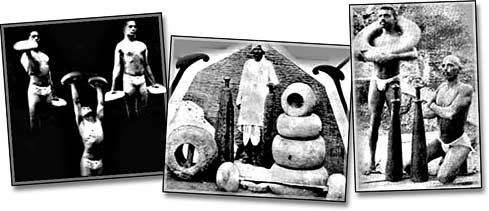
Though much has been made of the importance of physical fitness in the ancient Greek (and later, Roman) empires, the specific pursuit of bodybuilding did not yet exist. Instead, the athletes were trained in several sports and were expected to be consistent in each. These athletes were professionals in the truest sense of the word, and enjoyed great festivals in their honour at the conclusion of every sporting event. The very early Olympic games were held between cities, which each supported their own stable of elite athletes.
Unfortunately, quite a large gap exists between those early days and the middle of the 19th century, when bodybuilding began in earnest in North America and throughout Europe. At the first modern Olympics in 1896, there were two weightlifting events, variations of which continue today. Many North Americans were first exposed to bodybuilding through the strongman at traveling circus sideshows and carnivals. The man credited with ‘inventing’ many of the contemporary bodybuilding techniques was a German named Eugen Sandow, who, like many other strongmen before (and since), traveled with sideshows until the 1890’s. Before long, however, he came to see his body as a work of art, and began touring to show off his amazing physique during “Muscle Display Performances.” Hired as the personal fitness trainer to King George V, he was able to reach out to the public and advocate the potential of the human body through diet and increased physical activity. He was very influential in starting up a Ministry of Health, among other initiatives. As early as his influence was on bodybuilding, he is still revered as a deserving pioneer in the body building industry — as a tribute, the Mr. Olympia trophy is a gold statue of Sandow.
By the time Sandow died in 1925, bodybuilding had begun to take on some degree of popularity throughout England and Europe. Weightlifting equipment such as barbells and dumbbells were available commercially throughout the world, and a new generation of (mostly) men began lifting weights to create a more ‘masculine’ physique. To give you an example of the popularity of bodybuilding, who hasn’t heard of Charles Atlas? He was in his hey-day in the 1930’s, and he’s still a household name.

The “Golden Age” of bodybuilding is recognized as the years between 1940 and 1970. There were many new magazines devoted to the sport, and international organizations were in charge of hosting competitions for athletes worldwide. Most of us have an internal image, however stereotypical, of big guys lifting weights on the beach — it’s almost archetypal — but that place existed in Santa Monica, California. It has been referred to as Muscle Beach since the 1930’s. It was during this period when the basic ideology of bodybuilding was laid out: ‘train for health, strength, fitness and refined muscular development.’
For many, the bodybuilders of this period represent the height of masculinity. The competitors were huge, but still had some body fat. They were strong, but the average person could relate to them much more easily than anybody can to today’s ultra-chemically-enhanced bodies. Movies such as Tarzan and Spiderman featured bodybuilders-turned-actors in the roles of amazing super-men. Professional bodybuilders such as Lou Ferrigno and (now Governor) Arnold Schwarzenegger continued this trend from the 1970’s, taking us all the way up to today. For a great (if exaggerated) representation of bodybuilding in the 70’s, see the movie Pumping Iron. For many, that film represents the height of bodybuilding, even though those athletes are much less exaggerated than today’s.
Many believe that the sport of competitive bodybuilding has gone a little too far over the past twenty years. Whatever the case, constantly-improving supplements, steroids, and workout routines will ensure that tomorrow’s bodybuilders will be even bigger, leaner, and stronger. And probably more chemically tanned. And although all the right drugs and supplements help to refine the physiques of these athletes, it is undeniable that such an activity still takes an incredible amount of dedication and hard work. And we haven’t even touched on the subject of female bodybuilders! There are a multitude of resources on bodybuilders, bodybuilding and personal transformations on the internet. I generally try to avoid plugging other websites here, but bodybuilding.com is the BME of fitness.
Progress
It’s now been four months since I started my training, and it’s still going great. I haven’t missed any sessions (except when I’ve been out of town) and I haven’t let myself give up before an entire workout, even though I’ve felt very, very close to doing so. On occasion, the only thing that keeps me there is the thought that I know that I will recover in time. It is very often tough to push yourself without a workout partner, though I am doing my best. I find it’s easiest if I challenge myself to get the most out of my workouts.
What I’d never really considered before this month is how much the outside world can affect your dedication to consistent training. This has been a very tough month for me in many ways, and as we all know, this has a tendency to affect our bodies. I haven’t let this happen, however, and I am better off for it. I remain dedicated to my physical transformation, and though my goals are still formulating in my mind, I know I’m one step closer with every visit to the gym. I find it much easier to resist all the grossly fattening foods I used to feel so guilty about eating, and when I give in to temptation, I’m no longer riddled with that same feeling. I enjoy eating the occasional “cheat meal,” because as dedicated as I am, I still have to enjoy life. This has even rubbed off on my partner, who is now eating healthier than ever before (and seeing results after just a few weeks!) and enjoying herself at the same time. It just goes to show that you don’t have to starve yourself to lose weight — just a conscious decision to make the change for the better.
I now totally understand why “workout people” hate to miss a session. What one person calls obsession is simply dedication to another. If I miss one date at the gym, it sets me back almost an entire week. At this point I’m going to the gym six times per week: weightlifting is twice with my trainer and twice by myself, in addition to the three sessions of cardiovascular exercise I have recently undertaken. On Mondays and Thursdays I work my back, my shoulders and my arms, and on Tuesday and Friday I work my chest and my legs. Aside from having missed one session due to Thanksgiving and having trouble getting back into the swing of things, this “split routine” is going well. Certain areas of my body are reacting well to it, and others are still lagging behind. The problem with an area that’s not developing well is that it won’t improve if you just add more weight — you need to work out smarter, not harder, or the muscle fibers will not heal.
Unfortunately, on my first “alone” session without the trainer, I pushed myself a little too hard. At the time, I felt great. “Wow, I can push more weight than I thought!” But that led to problems at my next session with the trainer, because I could barely lift any weight at all. The same for the session after that. I had torn my muscles so badly that I hadn’t recovered in a whole week. It set me back and I promised myself I’d never do that again. The idea, as I’ve found out, is to stimulate the muscles into growing, not tear them to shreds so that they take forever to heal (and don’t necessarily gain you any strength or size once they have healed). Muscles get bigger and stronger while outside of the gym, and that’s why it’s important to eat plenty of healthy food and get lots of rest. You can tear the muscles all you want, but you won’t see any gains if you over-do it or fail to get adequate nutrition and sleep.
Statistically, I’m improving constantly, which has become my main motivation.
Former refers to July 14, the date of my first workout.
Current refers to November 7.Former Body Weight: 175.0 lbs / 79.3 Kg
Current Body Weight: 190.0 lbs / 86.2 KgFormer Body Fat: 20.7% — 35.2 lbs / 16.0 Kg
Current Body Fat: 15.0% — 27.8 lbs / 12.6.0 KgFormer Fat-Free Mass: 79.3% — 135.2 lbs / 61.3 Kg
Current Fat-Free Mass: 85.0% — 157.6 lbs / 71.5 KgSo…. that’s a total gain of 15.0 lbs. Fat loss of 7.4 lbs. Muscle gain of 22.4 lbs.
Again, I keep getting told that my progress has been amazing. Every time I look down at my still-fat ‘gut’, I am reminded that the second phase of my bodybuilding endeavor, the “cutting” phase (losing fat/cardio exercise) is just around the corner. My main priority has been to add muscle to my frame — if I had simply done cardio work from the beginning, I would have lost the fat by now, but I wouldn’t have had any muscle underneath it. And now I do, so I am preparing to start ‘chiselling’ down the fat and working on problem areas. I feel like a science experiment with all this weight gain and weight loss, and it’s only going to get worse, but better at the same time. I am excited to start losing fat, but I still feel like I need to gain a little more muscle (maybe 10lbs) before I do.

Unfortunately, the pictures I took don’t come close to showing the true changes in my body shape. I’ve gained inches everywhere, and muscles are now starting to separate and get bigger at the same time. Hopefully next update will bring a much more improved version of my body!

Dustin Sharrow
-
CLASH: This is Omo Valley [The Publisher’s Ring]
Written by

CLASH: This is Omo Valley
The urge to create, the urge to photograph, comes in part from the deep desire to live with more integrity, to live more in peace with the world, and possibly to help others to do the same.– Wynn BullockRecently BME had the opportunity to attend the opening of Liam Sharp‘s gallery show CLASH, being hosted at the Alliance-Francaise at 24 Spadina Road in Toronto (a two minute walk north from Spadina Station for TTC riders) — the show will continue there every day until January 10th.
The show featured photographs from his very recent trip to inner Ethiopia where he had the opportunity to photograph members of the Hamer tribe and others around the Omo valley that still practice ancient forms of body modification. We managed to pull Liam aside for a few minutes at the show and talk to him about his experiences.

BME: The thing that really surprised me is that you could still photograph activities like the big lip stretching — when I see it in books, it seems like it was disappearing forty years ago, but these are young people with these modifications. Was it hard to find them?
Liam: The reality is that there are very few areas still doing these things. It’s more and more difficult. I was just talking to someone that lived in Africa and he said that twenty, forty years ago you could just go outside the city and there’d be tribal peoples…
But even now, one thing you have to remember is that these cultures, these countries, are still extremely tribal. In fact, their governments are biassed in terms of tribes…
BME: As in for them, or against them?
Liam: Well both… The politicians represent certain tribes, so they’re slanted one way or another. That’s why there are coups and all these political problems — because the politicians really only protect the tribes they’re from. The tribes are identities or countries in and of themselves.
BME: With their own languages…?
Liam: They have their own languages a lot of the time, and also there are traditions you can see. There are three predominant tribes in this particular show — I visited about seven in all, and there are maybe fifteen in that one area. The Omo Valley region might be two hundred and fifty square kilometers. It’s not a huge area.
BME: How large are the individual tribes?
Liam: The Hamer tribe is about ten thousand people.
BME: So large enough that you never have to leave… you can stay inside the tribe, marry inside the tribe, and so on.
Liam: I think that’s how it’s done. I was photographing a guy from the Hamer tribe, the guy with the grip on the gun —
BME: I assume those are their guns? You didn’t ask them to pose with them?
Liam: No, no, of course not.
So I told him we’re going to this village in Oromati, and he said, “there’s no way I’m going there, if I step foot in that village, I’m dead!” since the Oromo are fighting the Hamer. The territories are extremely well defined, and they’re all kind of land-locked within those territories.
BME: They’re agricultural peoples?
Liam: Yes, very agricultural. But the terrain is extremely arid… I will never eat fried goat meat again — that’s all I was fed out there! Cows and goats, that’s it.
BME: How did you get there?
Liam: I was really kind of shit scared going on this trip… I sort of chickened out, but it’s important to do it this way and I always do it this way, which is to hire a local guide. I hired a truck with a guy — you can’t get there otherwise. The great thing about the guide is that he’s been in that area, and he knows the people, so he can smooth things over…
BME: Is that what he does? Just brings Westerners in?
Liam: That’s what he does… but in the whole time I was there I saw maybe five Westerners. So I’m not the only one, but there are very few… The others were there just to go I think, not to take photos other than just a few clips. That was one of the problems I think — their expectation that I would just take a few snapshots.
BME: How did they feel about professional photos being taken? Why did they think you were there?
Liam: That was always a big problem because my guide was always very suspicious of me. “Why are you taking these pictures? You’re going to make money from these pictures?”
And the fact is, as you can see, it’s not about the money. For me it was about going there and documenting these people, these tribal people, the way they live, and the way they are right now. But they didn’t like it. They wanted money — that’s what it was. I had to pay them three Birr, which is about forty-five cents Canadian per image [ed note: Liam took about 5,000 photos while on this trip]. Every time I clicked the camera, I had to pay. We had a suitcase full of money and my guide would just be paying it out.
BME: Isn’t that a bit dangerous?
Liam: It is… but it’s perfectly fine. You know why? Because paying money takes everything off the table. I’m going there and I’m giving them money and it’s an exchange. I’m taking their picture and they’re getting money. So it’s OK. That’s not a problem.
There was a situation when I was in the Omorati area, and photographed an older person, and the person collapsed
Are we going to get out of this situation, I was wondering? My guide said that if the old man had died, they’d have assumed the flash of the camera killed him — that this process, which they don’t understand, has killed this person. As soon as it moves to “you killed one of us” then very soon after it becomes “why don’t we kill you?” It’s very simple.
Luckily we ran over, and I supported him, and he was OK — but we got the hell out of there real quick!
They don’t particularly like the photographers. I really rode on the coattails of the relationship of my guide with the chiefs. As soon as that started to wear thin (which happened very quickly) I had to get out of there.
BME: Did you stay with the tribes, or just sort of roll into town, do your thing, and roll out?
Liam: We had a process — eventually it became repetitive and I was worried about that. What would happen is we would come into town, talk to the chief, and pay him off. As my guide was paying off the chief, I’d set up the backgrounds, set up the lights, and then he would tell everyone we were shooting and this is what the price was, and all that. Then I would just point to people in the crowd, and they’d come and I’d shoot them. One, two, three frames, and then the next person.
BME: They were OK with that?
Liam: They were OK, but it didn’t take long before they realized this was more than someone just taking pictures. They wanted to know what we were doing, what they were for — there was a big suspicion. I’m getting it here at the gallery too — questioning why I would want to portray Africa like this.
BME: One of the overwhelming comments I’ve heard walking around the show tonight is stuff like “oh, how disgusting they look” and “that one is even more mutilated than that one!” Does it seem strange to you that someone would come to your show and then say things like that?
Liam: No, not at all… That’s the biggest problem I’m had with going to places like this in the world. Westerners always look from this perspective, and that doesn’t respect these tribal peoples’ perspective. The fact is these people aren’t Canadian, they’re not living in this environment, and they don’t have the same culture. You can’t expect them to have our values and conduct themselves — or want to conduct themselves — like we do.
People are always asking me, “how could you take a picture of someone with a gun, how could you do this?”
The fact is that is how they are. That’s their culture, and that’s how they want to be! It’s just as ludicrous for them to wear clothes!
BME: You didn’t ask them to take their clothes off and paint their faces like that?
Liam: NO!!!! None of that is acting… That’s exactly —
THAT’S — HOW — THEY — WERE!
That’s it. That’s how they were.
\
Earlier we’d been joined by Roseanne Bailey, an African-Canadian woman, also a photographer who had lived and worked in Africa for some time. She expressed deep and very valid concerns that perhaps Liam was producing some kind of “savage erotica” akin to early exploitation films — and that by decontextualizing his subjects he might actually be doing them a disservice (basically a nice way of accusing him of being a racist and perpetuating the sins of colonialism because of his show).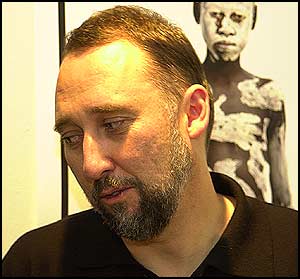
-
2003 APP EuroCon Report [The Publisher’s Ring]
Written by

2003 APP EuroCon Report
“Politics is supposed to be the second-oldest profession. I have come to realize that it bears a very close resemblance to the first.”
– Ronald ReaganGoing to my first APP convention, their recent EuroCon in Amsterdam, I didn’t really know what to expect. It’s been many years since I had any real dealings with the APP — fights over my support for scalpel piercing, dermal punches, and so on led me to believe that they were an overly conservative bunch of elitist piercers that weren’t particularly concerned with my “progressive” vision of the future of piercing. A few friends that “defected”, coupled with the APP’s continuing difficulty in drumming up much support from this community had me writing them off as not just useless but dead.



And then I went to EuroCon.
After attending almost every single seminar, and getting to talk to the board members and piercers, my mind was most definitely changed. I now see the APP as an essential and positive group that I hope all piercers will support and take part in — we need the APP! Having seen what they’re trying to do, I believe that the APP has the potential to be the backbone of the industry, serving to educate piercers, unite piercers, and present a strong front in dealing with the government and the mainstream public. The convention also illustrated the need for groups like the APP in keeping piercers informed and up to date on the overwhelming range of professional issues that can be very hard to keep up on in the absence of reputable trade journals and other organizations.
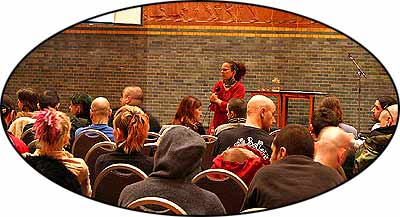
DAY ONE
Rachel and I took an overnight flight, arriving the morning the convention started. We stopped at our hotel for a nap and got to the convention space at about noon where we were greeted by Bethra Szumski, the current APP president, as well as other familiar faces such as Alicia Cardenas of Twisted Sol in Denver, and Megg Mass of Infinite in Philadelphia. We’d missed the first class or two (bedside manner I think), but after lunch an anatomy course was scheduled.
The anatomy class was being taught by Betsy Reynolds, an oral biologist who acts as somewhat of an advocate for the piercing community, counter-balancing some of the ludicrous statements made by anti-piercing dentists and so on. While the information she was presenting on healing was concise and relevant, I was a little surprised that it was being taught here at all — from my point of view it was disturbing that anyone wouldn’t know this anatomy in their sleep. The presentation was running slowly, in part because of constant interjections about piercing procedure. Eventually Paul King had to step in and ask that people save their procedure questions — this was an anatomy lecture and not intended as a technique debate.
At the end of the first day I was still pretty convinced that it was going to be a waste of time. The anatomy course had been boring, basic, conservative, and Aimee (see sidebar) was doing her damndest to make the attendees look bad — or at least have a bad time. At the end of the day Rachel and I walked around town a little, stopped for a rather bland meal somewhere, went back to the hotel and went to bed.

BETSY REYNOLDS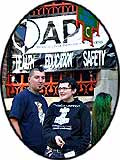
OUTSIDE THE BEURS
AT THE APP PARTY

SPAIN REPRESENTZ
DAY TWO
Seminars in theory started at 9:30, so a little after 9 AM I arrived and was told the seminar — basic piercing technique — was pushed back until ten. Technical problems seemed to plague the event, and it wasn’t until 11:30 that things actually got started, with the technique seminar being bumped to the afternoon. I think the only good news, echoed by the people sitting around me, was that Aimee had decided to “skip class” that day, so at least we didn’t have to put up with her disruptions.
Alicia then took over what was left of the morning with her stretching seminar. Given how basic the anatomy course had been, and because I’ve got more than a decade of stretching experience, I expected to be bored stiff — but I was very much mistaken! She started with diagrams showing exactly how stretching occurs on an anatomical level, detailing micro-tears and collagen replacement.
Dermal Punches and Scalpels
aka
Why is the APP so square?
Everyone knows that the APP presents itself as a conservative organization. In the early days, The Point ran articles damning people who used dermal punches and scalpels, or anything else that blurred the line between surgical technique and piercing — piercers such as Michaela Grey were adament in their anti-extreme statements and many believe she and others even got to the point where they were lying in order to present an overly conservative view. Now, with new staff, many of who grew up around the notion of pushing the boundaries of piercing, they’ve retreated to a “no comment” stance on these subjects, but it’s still something that puts off a lot of progressive piercers.That said, have you looked at the APP’s board and members?
I don’t know if they want me to say this, but you’ll see piercers there who have and perform dermal punches regularly. You’ll see piercers that use scalpels, and even piercers that do implants and pseudo-surgical procedures like tongue splitting — I’ve even heard a few acknowledge privately that they believe that in many circumstances a dermal punch is a superior tool to a needle and that they wish they could endorse it. They just won’t say that in public or attach it to the APP name in any way because of the legal issues.
What took me so long to figure out is the APP’s real role. The APP’s role isn’t cultural revolution. The APP’s role is not to fight battles with the government. The APP’s role, as I observed it, is to work with our “enemies” and to make slow and consistent changes inside both the piercing and the mainstream worlds in order to better this community. To do so, they can’t have their piercers going on public record as criminals! To illustrate with an example, conservative environmentalist groups like the World Wildlife Fund can effectively work with governments to protect the environment, but eco-terrorist groups like Earth First! have to resort to direct action since the government can’t negotiate with criminals — even if those criminals are in the moral right.
I think a lot of us in the piercing community, especially those that lean toward the kind of “no holds barred if it makes you happy pierce it” stance that BME espouses, don’t really understand this way of doing it — if we want to do a tongue splitting on our buddy, we’re gonna do it, state law be damned! But the fact remains that unless you want to be underground forever, making positive changes in the piercing community does include playing the politician — which means very slow change and a lot of compromise to get our way.
The APP probably isn’t going to do anything for someone who’s happy practicing out-of-sight, out-of-mind work in a small shop that doesn’t really have a future. The APP, at least as I see it, is there for people who see body piercing as a career. Their ranks are peppered with piercers in or approaching their 40s, who have families and homes, and shops with ten to fifteen years of respectable history. As much as a large part of me really likes being the “rebel industry”, logically I understand that if we are to survive above-board in the long term, the APP has chosen the right strategy.
Want to join the APP?
CLICK HEREAlso covered were stretching techniques, jewelry, and even lots of little tidbits for business owners like “stretching cards” (cards for your customers that encourage them to come back for slow and healthy stretching with incentives like 10% off on the next stretch if they wait). I do think Alicia has a little bit of an unfair bias against plastics, but she’s an engaging speaker that does a great job of covering basic material while throwing in enough trivia and advanced information to keep any level of audience enthralled.
After lunch, Bethra gave an in-depth and highly technical jewelry and metallurgy seminar. I was pretty tired at that point (still on Canadian time), and diagram after diagram of atomic structures was putting me to sleep. Since Bethra had prepared a hand-out with all the information, I took off for a nap. On my return she was just finishing up and Megg was about to start the basic techniques seminar, the technical problems having finally been solved.

HANDOUT EXCERPT
Megg’s also a great speaker and an experienced and progressive piercer who’s very good at presenting material that’s old hat to most people but with enough tips in it that I think even a piercing veteran would get a lot of out it, fine-tuning their techniques. Her seminar, prepared with Elayne Angel, contained numerous ideas that would improve any piercer’s work. Much of her seminar also focused on the subtle aspects of organizing a studio and its support staff to best facilitate and safe and pleasant piercing process.

AT THE APP PARTY
AT THE APP PARTY
AT THE APP PARTY

COLD STEEL REPRESENTZ

BRUNO AND BRENNO
FRANCE REPRESENTZ
SO MANY RAFFLE TICKETS

AT THE APP PARTY
DAY THREE
I showed up at 10 AM to again find that things had been pushed back even further — not so much for technical difficulties, but because people were simply late arriving. Maybe I’m a nerd, but if I had spent a few thousand dollars flying to a convention I’d go to the effort of showing up on time for the classes. I was surprised to hear that it’s not unusual at the Las Vegas convention for as many as half the people to not even bother showing up at all!
Meh.
The first seminar was one I’d wanted to take for a long time, the Bloodborne Pathogens course prepared by David Vidra and Health Educators, being taught by Alicia. This is one of those basic seminars that every piercer should know backwards and forwards, and like CPR certification, it’s the kind of thing they should be doing regularly to stay sharp. When it involves people’s lives — being able to provide a safe and aseptic foundation for your studio is the basis of this seminar — you don’t want to get sloppy!
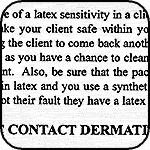

The presentation that followed was the one that really freaked me out and was probably the most eye-opening one of the event. Julien Ball of Prestige Medical, one of the leading autoclave manufacturers, gave an overview of modern sterilization technologies. It was fascinating to learn about the different procedures in Europe (for example, they use aggressive monitoring and charting of their clave’s performance, while spore tests are almost unheard of), but what really got to me was an overview of the difference between vacuum autoclaves and “normal” autoclaves.
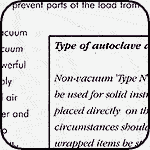


For those that don’t know, an autoclave sterilizes when the pressurized steam hits the surface of the items in the clave. If the steam doesn’t reach the items due to some blockage, sterilization doesn’t happen. Where it gets scary is that a simple pocket of air can, in some cases, provide this blockage. What that means is that a normal autoclave as is used by virtually 100% of North American studios can not guarantee sterilization of anything hollow (receiving tubes, tattoo tubes) or anything that has been placed in bags (basically all tools and jewelry) — there were definitely quite a few faces in that crowd turning white as Julien talked (see the handouts I’ve provided here for more information on this).
It was hard to get an answer out of Julien as to exactly what the risk level was — did these air pockets form every cycle, or one in ten thousand times? After all, Prestige Medical has a vested interest in the subject since there’s a higher profit margin in a $7000 vacuum clave than a $900 field-medic special! I was surprised to find out that about 70% of the piercers at the convention (the majority of the Europeans there) were using triple-pulse vacuum claves as well as single use water systems — some of the gear in the European studios was amazing. One German piercer even had an $8000 automated “tool dishwasher” in his shop!
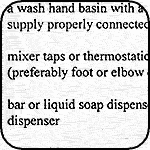
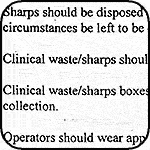

Al Prescott, organizer of the Derby conventions and developer of the Safe Working in the Tattoo and Piercing Industry vocational course, followed with an exhaustive seminar on risk management procedures which also touched on the extremely high standards that European (and specifically UK) studios are held to. I don’t think American or Canadian studios could match these without at least doubling prices — which might be a good thing since it could eliminate the low-end studios (although it could do the opposite since low-end studios tend to be more profitable and therefore more able to invest in new hardware).
The third day’s seminars ended with CPR certification which I skipped, but the day itself was to be capped with a party of everyone at the convention to give away some very generous prizes from the exhibitors — probably six thousand dollars worth of stuff was given away in the draws. Rachel won a belt buckle and some ring openers! I on the other hand won nothing…






DAY FOUR
The final day started with an aftercare presentation by Alicia, covering the pros and cons of a wide range of products in use by this industry. Unfortunately Aimee showed up about half way through it, shouting out a bunch of irrelevant questions which had already been discussed before she got there. I just don’t understand why someone would come all that way and act like such an ass… It was funny though — I think she must have clued in that she was pissing people off because when anyone would ask where she worked she was extremely evasive, just saying things like “a place on the east coast”.
Paul King’s informative and entertaining “amateur piercing anthropology and history” seminar followed. Paul is definitely a guy who I’d call a “piercing nerd” — someone who can go on and on about it and is interested in every little silly piece of trivia on the subject. Given that’s how I’d also describe myself, and given that it’s so hard for any one person to get a real picture of this community (so much of it is still oral history), it was wonderful to be able to assimilate his stories — many of which have been making their way into the new BME encyclopedia project (which will be officially unveiled on January 1st, 2004).
His stories about the rituals he watched during his travels in Penang were especially touching. We’ve all seen the gory photos of hundreds of thousands of people marching through the streets with giant cheek skewers — they seem so different from us — so enlightened. We are given the impression that they do these things naturally, and that everyone is in touch with God. That’s not entirely true though. Just like here in the West the occasional person will have to abort their suspension because they’re not ready to accept it, or it’s just not the right day, the same happens in Penang. I think the most moving photo I saw the whole time I was in Amsterdam was a young man sitting, emotionally exhausted, not able to take part in the ritual — and in his face I saw the same face I’ve seen in my backyard whenever someone asks to be pulled down from a suspension early because they can’t handle it.
It was at that moment, Paul said, that he realized that all of us in this world are the same.
Megg gave the final seminar, on legislation. I wasn’t sure how this was going to go over because some of the European piercers were already annoyed at the American bias on some of the subjects. However, the seminar didn’t talk specifics — its goal was to help teach people in down to earth terms how to deal with politicians. Given that Megg has helped Philadelphia come up with some of the best piercing legislation in the world, she’s more than qualified to teach this. Her anecdotes of her own successes in this area should be effective strategy for anyone around the world facing the same issues.
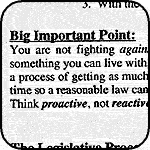
HANDOUT EXCERPT
The day finished on a bit of a sad note though, as Bethra thanked everyone for coming, and let them know that, for financial reasons, this would probably be the last time the APP would host a European convention. However, the day before the convention started they’d hosted a mini-event introducing all of the heads of the fledgling European professional piercing organizations — some had only two or three members, but I think they walked away empowered, and thanks to seminars like Megg’s legislation one, with new plans of attack as well.
I think everyone there was looking forward to the day when we’re able to have a world piercing convention, hosted by dozens of professional groups from all over the world.

MEXICO REPRESENTZ
BRUNO, CHRISTIANE, AND
TEN YEARS OF PAIN
ALEX AND FOXX

MEGG MASS AND PAUL KING
LIVE PORNO: CASA ROSSO
I don’t know how many of the other attendees checked out the live sex shows. I was sort of hoping to see someone we recognized when Rachel and I went, but it was pretty much only Asian businessmen. We had no idea what to expect — after all, it really is people screwing on stage. I think we were hoping for something absolutely sordid, but it was really quite civil and mundane. Being hosted in a real theater with fully clothed male waiters made it very non-threatening — in some ways the salacious window prostitutes are a lot more pervy.When we got there a Vietnamese girl was doing some mellow stripping followed by a ben-wa ball act — because she wasn’t working for tips she didn’t really “sell herself” to the crowd like one expects in North America, giving it a very strange and aloof vibe. She was followed by a rather plastic pornstar-looking woman having sex with an absolutely disinterested looking fellow that I’m pretty sure was gay — but he did have a really nicely done full tribal sleeve. They went through a few positions and after maybe four or five minutes the curtain closed on them — no money shot since they have to do this act for hours and hours. Casa Rosso is built around a series of sex vignettes over a repeating hour-long show.
A dildo act followed, and then another couple — tattooed again, with him wearing a large dragon shoulder-cap. They probably weren’t as attractive as the first couple, but the chemistry between them was good. After them came a comedic banana act that included good-heartedly playing with a few audience members on stage, culminating with them eating a banana out of the performer — it wasn’t as dirty as it sounds — funny would be a better word for it. She was obviously having a good time, so it was more like a strange kind of perverse stand-up comedy.
After another couples act, the banana girl was back. The curtain opened to reveal her in a grim reaper costume, complete with an enormous scythe. After a moment of silence, old school Metallica began blasting — I’m really not a fan of stripping on the whole, but the humor in a heavy metal demonic strip show won me over. Once nude, she unrolled a giant flag with a pentagram in the center and spread it out on the stage, which raised up into a central pedestal. In the middle of this pentagram altar she performed a dildo act with a flaming candle… Again, not something I’d necessarily call erotic, but definitely a hilarious show that I don’t think you could see anywhere else.
We didn’t stay for the entire show, but as we were leaving one last couples act performed, starting with a slow but intense blowjob and then really passionate — and elaborate — standing sex. Because of the erotic energy between them this act definitely made me very nervous about having to walk past the obviously excited businessmen sitting next to us. The aisles were packed tight and I wasn’t really looking to become part of the act!
All in all, I’d recommend checking it out as a “just so you can tell people you did” sort of thing, but if you’re looking for raunch you’ll find more of it at an American strip club… or even the average BME BBQ!
SOFT DRUGS: BABA
We didn’t have a chance to check out the coffeeshops until the last day. That’s actually not entirely true — we’d walked past quite a few, and almost went in a number of times, but instinct just tells you it’s wrong. It was more a matter of finding the courage than finding the time. Even though you know it’s legal, you still feel like stormtroopers are going to throw you into a cell for even stepping foot inside these “soft drug” emporiums.We ended up at a place called Baba’s, just down the street from Mr. B’s, the well known SM shop — so as leather-daddies walked past us in full gear, we went to the desk. Right there on the menu were joints, and a big stack of them sat behind the counter… or we could see the “house dealer” if we just wanted raw materials.
“Could I have a pear juice and a coke please”, I asked, meekly followed by “…and a joint,” not really knowing what to do or expect.
“Would you like a hash joint, or marijuana?”
“Marijuana please.”
And it was really as simple as that. Looking around, the coffee shop wasn’t full of stoner-types (except me of course) — middle aged folks, thirty-something well-dressed women, and the occasional tourist. It felt really normal and healthy, but still, I felt so nefarious lighting up that joint! I smoked about half of it, and Rachel had a bit as well, and with big grins on our faces we wandered through the streets of downtown Amsterdam.
THE CONVENTION FLOOR
A small but nice cross-section of jewelry suppliers from around the world had booths at the event. Most of it was the same stuff that you’d see at every single tattoo convention — in all honesty I think they could have done without the floor. That said, I’d like to mention Quetzalli, an organic manufacturer from Mexico that had truly gorgeous examples of ammonite-inlaid ear jewelry as well as plugs filled with intricate and beautiful beadwork.






CONCLUSION
I met a lot of really wonderful people — a lot of old friends, online friends, and many new ones as well. Bruno and Brenno from Italy were wonderful — talented piercers and body artists full of enthusiasm in their fledging association. Christiane from Norway showed me Håvve’s new book, Ten Years of Pain, about the history of the Pain Solution performance art group (the book is wonderful and I hope to have it in BMEshop soon). Russ Foxx from Canada was great fun to see, as was Carlos Escobar of Spain. It was also nice meeting piercers like Alex from the UK who I knew from the good things their many clients I deal with all the time said about them.
I know I’m forgetting people! I apologize!
I also met with Andrea (Lacrima Rubra) from Germany who showed me video of years of her performances and introduced me to some new friends and other friends who — like so many of my acquaintances — I know only by their genital mods! I also got to see my old friend Patrick Bartholomew again which is always nice, and Kor (Ego Kornus) really impressed me as well. It was very interesting to talk to a performer who comes from an art (modern ballet) and ritual background more so than a body modification background. And the forty or so beers we drank that afternoon between us polished off that day very nicely!
I could name people endlessly and still forget some who made the event worthwhile for me, so I’ll get back to EuroCon itself. I had three main problems with the APP convention that I think to be fair I should mention. First, I thought parts of it were disorganized and unprofessional, resulting in things like handouts not being ready on time and projection systems not working — given the expense that had been gone to in hosting, and the fact that the attendees had spent a lot of money to come I thought this was unfortunate. That said, as someone who’s hosted events, I know this is pretty normal.
Second, I thought better fact checking could have been done. While the presentations given by specialists were very strong, some of the more general reports were riddled with historical errors, typos, and substitutions (naming the wrong soap as vegan and so on). They were just little things, but I felt that it’s that final touch that really makes a presentation perfect.
Finally, an exceptionally poor job was done in marketing and promoting the convention. Most of the European piercers I talked to had absolutely no idea there was an APP event in Amsterdam, and those that did assumed it was for Americans only and not oriented to Europeans. A lot of the value of the convention came from dialog with the attendees, not just the lecture sessions, so this mistake was their most serious.
Let me be very clear though — those complaints are listed in order to be thorough and honest. I do not believe that they tainted the conference to the point where it wasn’t worthwhile. While the majority of the information being presented was old hat to me, there were still volumes of knowledge being shoveled that was new and that I needed to hear — and that every piercer needs to hear.
The next APP convention — a much larger one that draws over a thousand piercers (some of the best in the world) — is at the start of May, 2004 in Las Vegas. Now, it happens to coincide with Shawn Porter’s wedding, so I’m going to have to miss a day, but assuming that America doesn’t stop me at the border, I’ll be there, eager to keep learning. I hope you’ll be there too.
See you in Vegas,

Shannon Larratt
BMEzine.comPS. Thank you to the APP for inviting me to come and being generous enough to extend my press passes into the seminars. Thank you as well to Bethra, Megg, Paul, and the other APP members for making me feel welcome. Finally, thank you to them as well as Julien, Al, Betsy, and the other speakers for sharing their knowledge.
-
Suspensions & Tensions: Yesterday – Fakir Rants & Raves
Written by


Suspensions & Tensions:
Yesterday"Your body belongs to you, and in the appropriate ritual, it has been given to you to explore the full dimensions of your being."
In 1943, a young teenage boy in South Dakota was bored to tears in the stifling, restricted and limited environment around him. He haunted libraries hoping to find a glimmer of something different, exciting, vital and alive in the world beyond. In the school library, in a musty alcove he hit pay dirt — a complete collection of old National Geographic magazines dating from 1905! Here were pictures of people who looked different, lived differently and had done radically different things with their bodies. This was exciting, WOW!
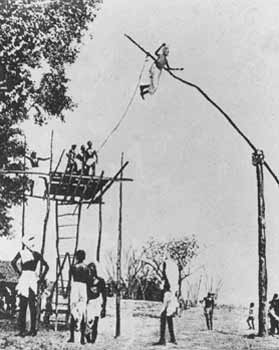 Early photos of Savite Hindu devotees during Chidi Mari Festival in South India (Madras, 1920’s). After hooks are pierced in the back, the devotee climbs a high tower where he (or she) is lifted into free air by a horizontal pole and slowly rotated.
Early photos of Savite Hindu devotees during Chidi Mari Festival in South India (Madras, 1920’s). After hooks are pierced in the back, the devotee climbs a high tower where he (or she) is lifted into free air by a horizontal pole and slowly rotated.One photo in particular attracted his attention. In a 1920’s issue he saw photos of young men and women in India with hooks pierced through their flesh hanging fully suspended by their flesh from a rotating cross arm high in the air. Why did they do this, he wondered? How could they do this? What did this feel like? What did it do to you? Several years later, the boy found some descriptions and drawings of Native Americans who also pierced their flesh and either pulled for hours against deep piercings or hung suspended by them.
Discovery of these Native American rituals rang many bells for the boy since many of these rituals had taken place in the same physical space in South Dakota he now occupied, and only about fifty years prior. Following a psychic trail on his bicycle, he found several places where Lakota, Arikira and Sissiton peoples had pierced their flesh and pulled against it. The vibes were still there beneath the rustle of cottonwood leaves on the trees from which they pulled and hung.
The feeling left in these places was infectious. The boy was intoxicated by it. He had to try this himself. In fact, he felt like he had done this before. That boy was me. He has since tried these body rituals many times. Now some fifty years later, in 2003, he finds himself in a strange new world — one where many others have also felt the urge to pierce their flesh and either pull against it or be suspended by it. However, some of these explorers seem to think they’ve just invented the wheel and want some kind of patent on it to claim ownership. So now we’ve got “Superman” and “Coma” suspensions and other new names that just didn’t exist in the world of the people who originated these rituals. But that is ok as long as some credit and honor is paid to the people who came before and showed the way — as long as the inner “magic” and “sacred space” belonging to these rituals is not forgotten or ignored.
ORIGINS & BELIEFS
The practice of piercing the flesh then pulling or hanging by pierced body parts is not a new custom. It has been a part of Hindu Culture in Southern India (Tamil Nadu) for thousands of years, nearly as long among the Sufi of the Middle East, and for hundreds of years as a part of religious ceremonies of Native Americans. It is, until recently, an alien and forbidden custom in mainstream Western Cultures. What useful purpose could this custom have? Why would anybody deliberately choose to “mutilate” their flesh and “suffer” thus? A huge conflict exists between Western Culture and those where such piercing rites are honored and encouraged.
The core of this conflict centers around different cultural beliefs about the body. Who does your body belong to? A distant God who has strict rules about what you can do with it? Or to a Priest or other intermediary of this real or imaginary divinity? Does your body belong to a father or mother? Or to a husband or spouse? Or to the state or a social order or tribe? Does anyone besides you have the right to decide what you can or cannot do with your body? Or does it simply belong to you the one who lives inside?
In those cultures where piercing ceremonies have developed, the attitude is pretty much universal: your body belongs to you, and in the appropriate ritual, it has been given to you to explore the full dimensions of your being. In Western Cultures of the late 20th Century, some of these alien beliefs have replaced old Judeo-Christian ones. Since the 1970’s the widespread practice, acceptance and popularity of body modification definitely says, “My body belongs to me!” However, like many customs and practices that originated in other cultures and were transplanted here, only part of the messsage seems to have been transmitted. For example, the art of tattooing was brought to Europe from the South Pacific by sailors and early explorers. In Somoa and the Marquesas, the custom of tattooing was a very sacred and special rite: “the making of a magic mark”. It was an initiation, a rite of passage, and meant to transform forever the one who bore it. The early sailors brought back the technique to make the mark — but failed to bring back the magic. So soon European tattooing became a mere novelty: marks that don’t wash off, a status symbol of sailors and outcasts. The meaningful and magical geometric designs of the originators were replaced with the only kind of graphic Europeans understood: crude representational pictures or words. The magic and purpose of the originators had been lost in translation.
In most cases, I feel the same thing has happened to the suspensions and related piercing experiences a lot of people are doing today. They are often being done for sheer novelty, attention, and ego satisfaction. I feel very strongly that if one borrows a custom from another culture, it is your obligation to respect and understand, as best possible, the significance and mystery of the practice. Otherwise, it can easily fall into darkness or misuse and undesirable consequences or spiritual degradation can result.
However, at the same time, I feel everybody has a right to do what they will with their body even if it is for sheer exhibitionism. But they should be aware they are missing the full potential and magical significance of the act.
SAVITE HINDU & SUFI PRACTICES
The oldest recorded history of piercing the body and pulling on or hanging by the piercings goes back perhaps five thousand years to the earliest cultures of India. In this great period of human development in the East, the concepts of Hinduism including the various yogic disciplines, understanding of energy centers (chakras), tantra and the Kama Sutra were born. The body/spirit connection was especially explored, and the ability to attain different states of consciousness was both sought after and revered. The idea of “using the body to transcend body” played an important role in religious and everyday life.
Two major Hindu Festivals are especially focused on body piercing rituals: Thaipusam in January/February and Chidi Mari in May/June. Both festivals are celebrated primarily by Savite Hindus (devotees of Lord Siva, Muruga, Murugan, Subramanya, the Great Mother Mari and Kali). Other Hindus, like the followers of Vishnu or Krishna, do not usually practice body rituals or employ body piercing in their religious practice. In fact, they often hold these rites in contempt. The Savites are mostly the dark-skinned Tamil people of Southern India (Tamil Nadu) and direct descendents of the original indigenous peoples of India. Their Tamil language used in the chants of their “Pujas” (worship) is the spoken equivalent of the ancient written language of Sanskrit. Historically, the Tamil peoples have been persecuted for hundreds of years. First by the light-skinned Northern Indians, descendents of Aryan invaders, then by the British colonialists who hauled them off as virtual slaves to work on tea plantations in Ceylon (now Sri Lanka) and other parts of the British Empire. Wherever they’ve been taken by force, the Tamil people have been remarkably successful in preserving their culture and spiritual practices. Something similar is now happening with the culture of Tibet.
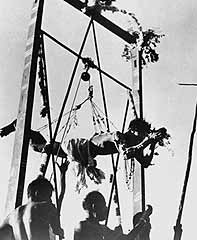
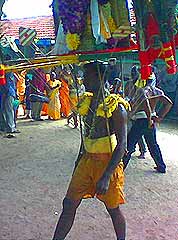
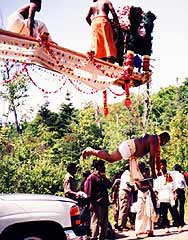 Above, L-R: Thaipusam hook-swinger in Ceyon in the 1930’s (Is this Superman?), recent Hindu rituals in Melacca (West Malaysia), and Kavarti at the Sivananda Ashram in Val Morin (a man suspends from a rig on a pickup truck). Below: Group rituals at the Sivananda Ashram.
Above, L-R: Thaipusam hook-swinger in Ceyon in the 1930’s (Is this Superman?), recent Hindu rituals in Melacca (West Malaysia), and Kavarti at the Sivananda Ashram in Val Morin (a man suspends from a rig on a pickup truck). Below: Group rituals at the Sivananda Ashram.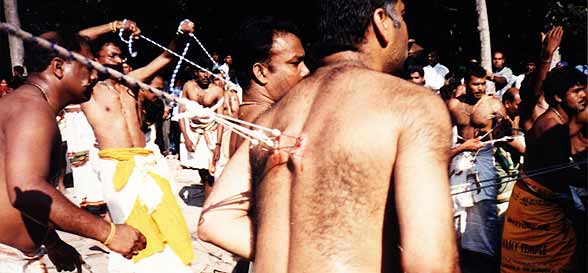
As public festivals, both the Thaipusam and Chidi Mari have been effectively outlawed in India and Sri Lanka. Too barbaric. But in other parts of Southeast Asia, especially Malaysia and Thailand, these “torture festivals” still flourish. The Chidi Mari Festival is devoted to worship of the “Great Mother” (Mari) and other female deities like Kali. Devotees are often pierced by two hooks in the back, suspended on the end of a long pole and rotated high in the air. Others are pierced with multiple hooks and suspended horizontally for long periods of time (two to six hours). All this done to attain a “State of Grace” (ecstatic trance) in which the Great Mother possesses their bodies and bestows enlightenment and blessings on them and their families.
Thaipusam is a piercing festival to Lord Siva and especially the Hindu dieties who are “Stars in His Crown”: Muruga, Murugan, Subramanya, Skanda, Ganapati. Devotees vow to bear a gift to the deity (archtype) under physical hardship. This is considered the purest of gifts — the offering of one’s own body pierced with spears, skewers or hooks as it delivers the gift. This is “Worship Through the Body” and such a gift is especially accepted and blessed by such deities (archetypes) as Murugan, Lord of Piercing and patron Saint of the Tamils. When I witnessed the Thaipusam in Penang Malaysia in 1995, I felt the reality of the sacrificial energy released. It was overpowering, intoxicating, sweet, and very similar to the energy that I have experienced at many of the body suspension and hook pulling rituals I have facilitated or witnessed in recent years.
This same energy has historically been a part of Sufi body piercing rituals dating back hundreds of years. In case you don’t know, Sufi is a fusion of ancient Hebrew, Hindu, and Islamic beliefs and practices with emphasis on individual “gnosis”, that is “direct knowing” by means of altered states. Sufi sects that still practice piercing rituals, dervish dancing, and other trance rites are not accepted by mainstream Islam and have been forced underground except in the United States and a few other Western cultures. I even know of one of them in Marin County, California! One of my ardent pro body piercers learned Arabic and was attached to that group. My namesake, the original Fakir Musafar, was a 12th Century Sufi mystic from Meshed, Persia (Iran) who for sixteen years had six daggers embedded in his chest and back plus six horseshoes suspended from twelve permanent piercings in his shoulders and arms. Musafar’s message was much the same as mine: one can access the unseen worlds and find the source of being through the body. Legend has it Musafar was ridiculed for his bizarre practices and that he died of a broken heart because his message went unheard. In many ways, I feel the hand of Musafar and the energy of Murugan in what I have been doing for some fifty years. I also feel the Spirit of the Modern Primitive is an extension of that same ancient and timeless energy.
NATIVE AMERICAN PRACTICES
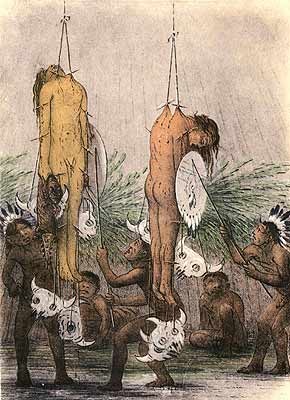 Catlin’s 1800’s painting of O-Kee-Pa: A Religious Cermony of the Mandan. This art is scanned directly from the original litho page in his 1867 book published by Trubner & Co., London. A precious find, this original leather bound copy belongs to Fakir!
Catlin’s 1800’s painting of O-Kee-Pa: A Religious Cermony of the Mandan. This art is scanned directly from the original litho page in his 1867 book published by Trubner & Co., London. A precious find, this original leather bound copy belongs to Fakir!Strange as it may seem, the practice of piercing the body and ritually pulling or suspending it to achieve some kind of union with divine powers developed quite independently on the North American continent. The exact time frame is unknown since there are no written records left by these tribal peoples — only verbal records and stories told to Europeans in the late 1700’s and early 1800’s. The most significant chronicler of these customs was George Catlin, an Englishman who lived among the Mandan people in the 1830’s and both wrote and painted descriptions of their body rituals. The Mandan, who were not hunters and gatherers, lived in villages and cities along the Missouri River in what is now South and North Dakota. The primary Mandan suspension ritual was called the O-Kee-Pa. It was both a rite of passage for all young men and also a repeated practice for a vision-seeking shaman. Mandan legend says the practice was given to them by a white man who came down from a mountain in ancient times.
After many days of fasting and extreme ordeals, Mandan young men who were about to become adults and enter adult life were pierced twice in the chest and twice in the back. Under the guidance of an older man who had taken this journey before, often many times (called a Ka-See-Ka meaning guide), they were suspended by either set of piercings from the roof of a lodge. In extreme pain, followed by trance, the young men were hung up for about twenty minutes to seek communion with “The Great White Spirit”. Legend has it that initiates traveled out of their bodies in this state and were guided through unseen worlds by their Ka-See-Ka who knew the way. The O-Kee-Pa journey was like a canoe trip on a tricky river: the initiate submitted and just rode in the canoe while the Ka-See-Ka steered it to appropriate vistas and to avoid rocks. Through the years, neighboring tribes, especially the Arikara and Minnetaree, were exposed to the Mandan ritual and developed their own piercing rites, often more severe.
Various Sioux (generic French word used for all tribal peoples living in this area) tribes like the Lakota, Ogalala, Teton and Yellow Hand also adopted or developed shamanic piercing rites — chief of which is called the Sun Dance in which pledgers are pierced once or twice in the chest, fastened to a tree or pole and vow to pull against the piercings until the flesh breaks. Again, the object is to enter an extraordinary state and meet an animal ally or the “Great White Spirit” — either as communion, healing or to obtain special knowledge. The most serious initiates and experienced dancers gained great respect and awe for how long they could pull against the piercings without breaking free. Sometimes this would be several days.
Wonderfully accurate movie reenactments of the O-Kee-Pa and Sun Dance can be seen in the Richard Harris films “Man Called Horse” and “Return of the Man Called Horse”. A documentary film of a real modern day Sun Dance and O-Kee-Pa style suspension can be seen in the film “Dances Sacred & Profane” shot in Wyoming with Jim Ward and Fakir as initiates. When this film was released on videotape it was called “Bizarre Rituals”. Watch my web site for a new tape to be released soon with the last thirty minutes of the “Dances” film plus a short profile of Fakir produced by French filmmakers and Canal+ for European distribution.
Yours for safe and enlightened body rites,

Fakir Musafar
fakir at bodyplay dot com
In my next column, SUPENSIONS & TENSIONS: TODAY, I will bring these practices to contemporary times with accounts of my own experiences and the experiences of others. I also wish to alert those who currently do piercing rituals with large hooks of a new and recent danger: MRSA (Methicillin Resistant Staphylcoccus Aureus), a staph infection that is resistant to all current forms of antibiotics. It is real. It is here and I recently had to deal with a case that required two open-heart surgeries! It is easily transmitted by mere physical contact. It is then called CA (community acquire) MRSA. More on this new danger in my next column.
Fakir Musafar is the undisputed father of the Modern Primitives movement and through his work over the past 50 years with PFIQ, Gauntlet, Body Play, and more, he has been one of the key figures in bringing body modification out of the closet in an enlightened and aware fashion.For much more information on Fakir and the subjects discussed in this column, be sure to check out his website at www.bodyplay.com. While you’re there you should consider whipping out your PayPal account and getting yourself a signed copy of his amazing book, SPIRIT AND FLESH (now).
Copyright © 2003 BMEzine.com LLC Requests to republish must be confirmed in writing. For bibliographical purposes this article was first published November 15th, 2003 by BMEzine.com LLC in Tweed, Ontario, Canada.
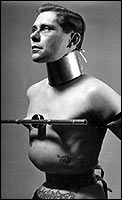
-
Self Definition and Body Modification & Ritual – Through the Modified Looking Glass
Written by

Self Definition and
Body Modification & RitualThe surest way to corrupt a youth is to instruct him to hold in higher esteem those who think alike than those who think differently.
– Nietzsche

